More Discoveries for ‘Otto Ege Manuscript 14’
August 3, 2020 in Manuscript Studies, Uncategorized
Some Known Leaves
from ‘Otto Ege Manuscript 14’
In Sequence
[Posted on 3 August 2020, with updates.]
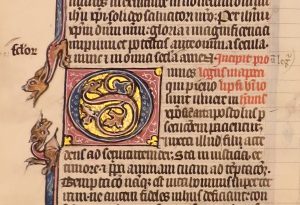
Beinecke Rare Book & Manuscript Library, Otto Ege Collection, Family FOL Portfolio, Leaf 18 original recto, opening of Apocalypse Prologue.
We offer an updated and illustrated list of some of the leaves — not all — which have come to light from the dismembered and widely dispersed copy of the Vulgate Bible in large format now known as “Otto Ege Manuscript 14”.
It takes its name from the owner, Otto F. Ege (1888–1951), who took it to pieces and destroyed its integrity as an intact volume which had been purchased at auction in New York after World War II. It takes its Number from the number which Ege assigned to it in the series of specimens from similarly dismembered medieval manuscripts arranged in his Portfolio of Fifty Original Leaves from Western Manuscripts (FOL for short), numbered 1–50.
There the specimens are presented in matted frames of uniform size and provided with a printed label which cites the Leaf Number and offers a paragraph with some generic observations about the manuscript, the author, the type of script, the genre of text, and suchlike. The label was worded so as, presumably, to suit many different leaves from a given book.
Within the frame, the manuscript leaf would stand behind the windowed mat which obscures some of its exterior features. The hinged mat allows (if permitted by the owner) for opening the frame to inspect the full extent of the leaf and, it may be, to lift the leaf so as to observe features on its other side. Not infrequently, Ege turned the original rectos of the leaves to the verso position in the frame, so as to display whichever features might be deemed preferable for display.
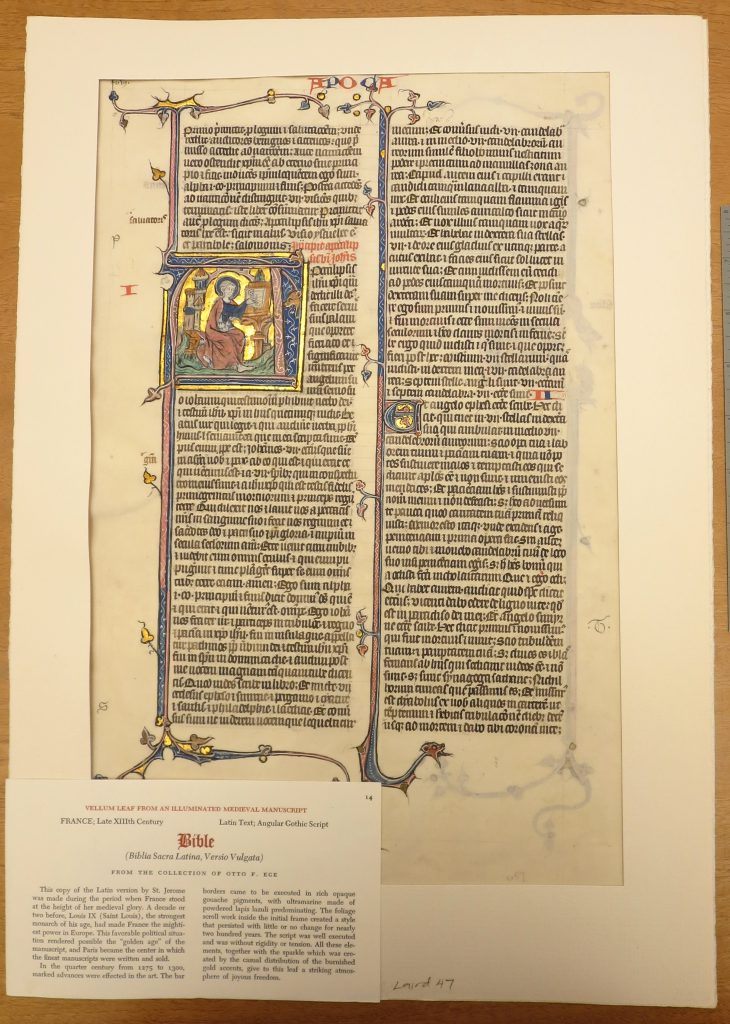
Beinecke Rare Book & Manuscript Library, Otto Ege Collection, Leaf with the opening of the Book of Revelation within Ege’s mat, which turns the original verso to the front.
The former manuscript had many more leaves than the number required for the 40 numbered Sets of the FOL Portfolio — plus any unnumbered Sets, of which perhaps 1 or 2 are known. As characteristic of Ege’s distribution strategies, individual leaves could have their own mats and, often, their own labels.
The current locations of a number of Sets have been identified, and more may come to light. So too, many other leaves have turned up in various collections. The work of identifying them as belonging to Ege Manuscript 14 and discovering where they are preserved represents a significant stage in the recovery process. That many have passed through the sales rooms of auction houses and book-sellers, sometimes more than once, introduces challenges to that process of discovery.
“The Long Shot”
On display among “New Acquisitions” Exhibition at the Beinecke Rare Book & Manuscript Library in November 2016, separate sections of the Bible stand in a row, accompanied by 2 Beinecke exhibition labels on paper boards. From left to right: “Lectern Bible” Label; 1 detached Board from the former Binding, with marbled endpaper and an effaced blue label or bookplate; 2 “stacks” or “piles” of segments of loose leaves in nested bifolia; “Family Album” Label; and 1 leaf from the “Family Album” in its Ege mat, with its Ege label for Leaf 14.
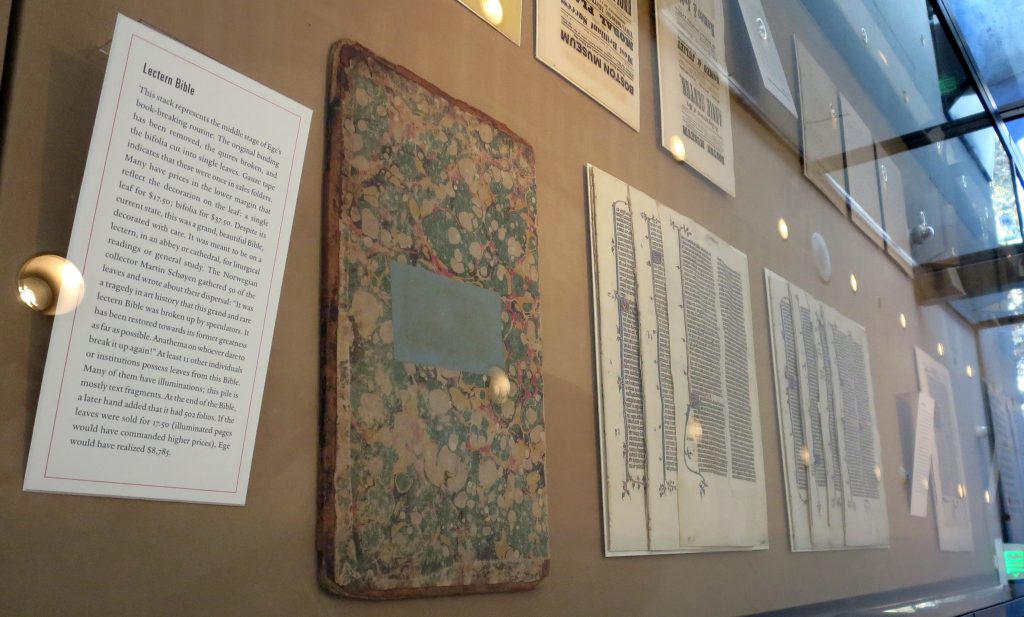
Beinecke Rare Book & Manuscript Library, Otto Ege Collection, New Acquisitions Exhibition (2016). Ege MS 14 in pieces.
A closer view of the 2 “stacks” or “piles” of disbound leaves. They display respectively 3 and 4 segments of manuscript leaves or bifolia. Let us call them, from left to right, Stack 1 (× 3 Segments) and Stack 2 (× 4 Segments).
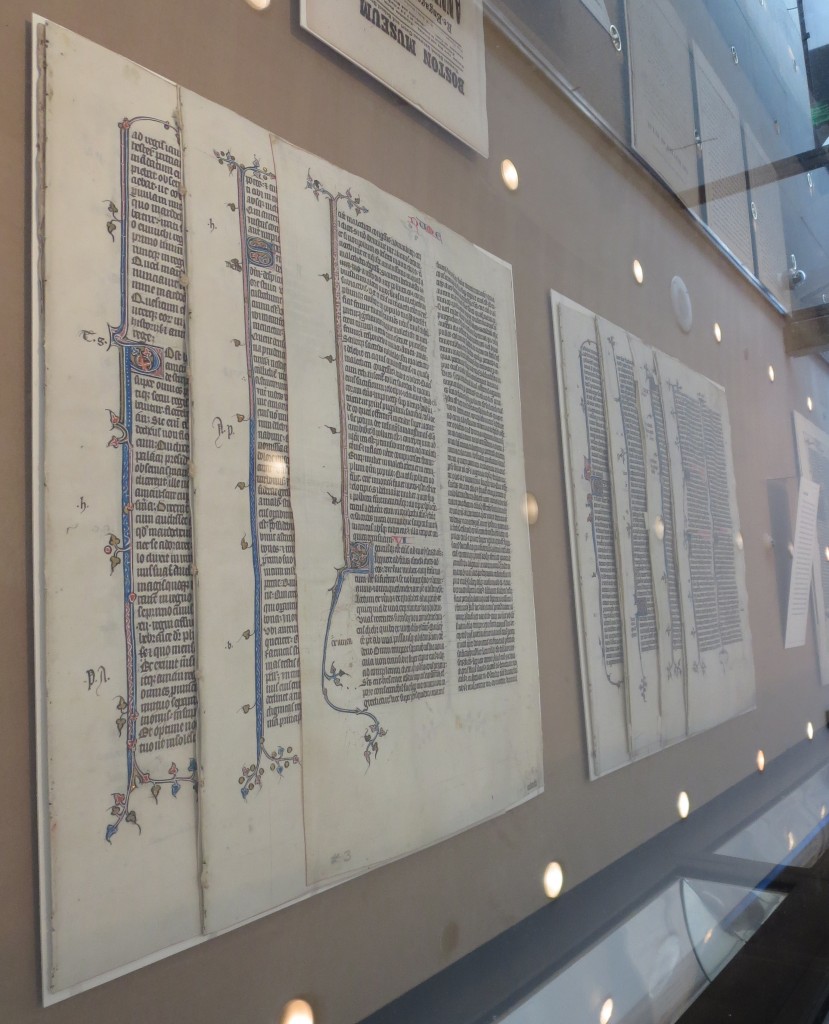
“A Long Shot”. New Acquisitions Exhibition at the Beinecke Rare Book and Manuscript Library in November 2016: View of Some Parts of “Otto Ege Manuscript 14”. Photograph by Mildred Budny.
Stack 1
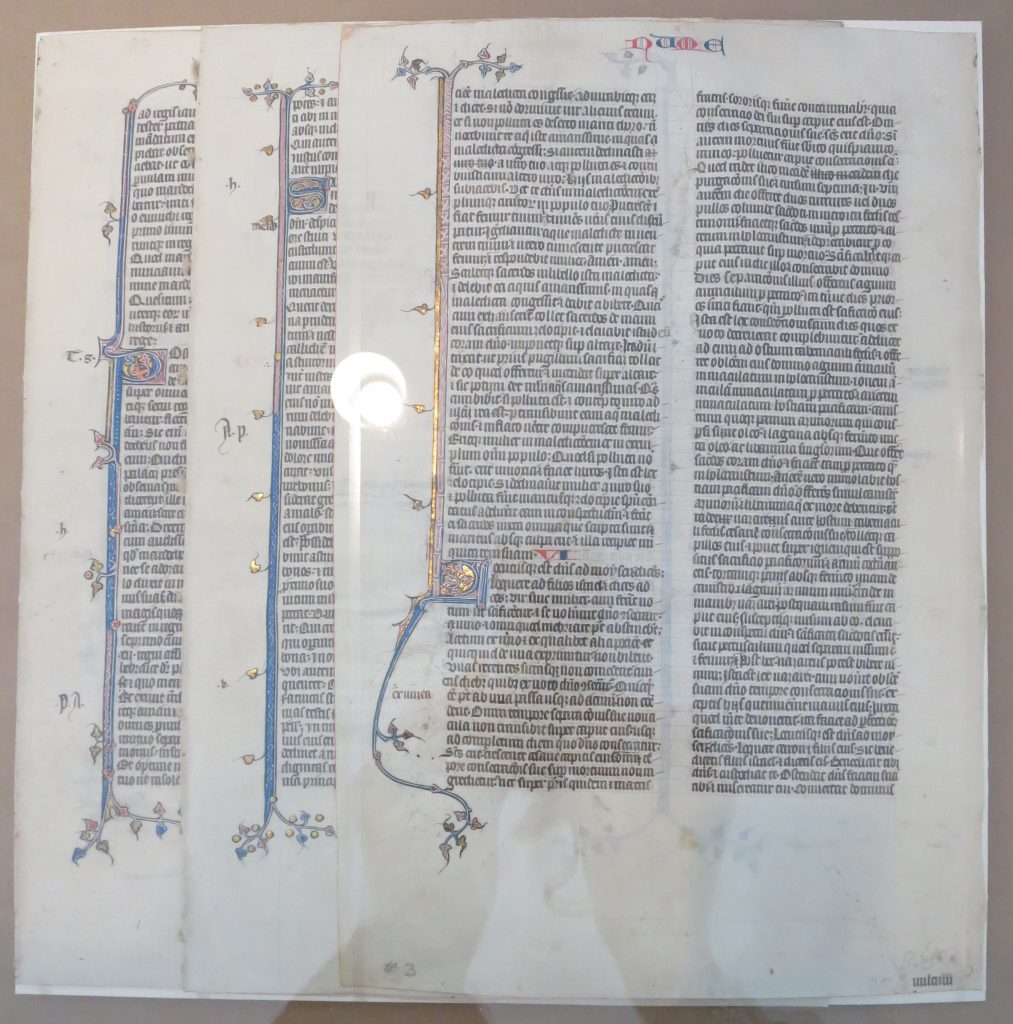
Beinecke Rare Book & Manuscript Library, Otto Ege Collection, MS 14 Segments, with verso for Numbers 5:88 – 6:26 on top. Photograph Mildred Budny.
Segments of Leaves from left to right
Segment 1.1: Esther 2:19 ([Mordocheus manebit /] ad regis) – 3:8 in column a on a recto (seen in part here)
Segment 1.2: Proverbs 13:22 ([et ne-/]potes et) – 14:28 in column a on a recto (seen in part)
Segment 1.3: Numbers 5:18 ([cum execra-/]tione)– 6:26 (convertat dominus [/ ultum sum]), plus catchwords (ultum sum) at the bottom, on a verso (seen in full)
Stack 2
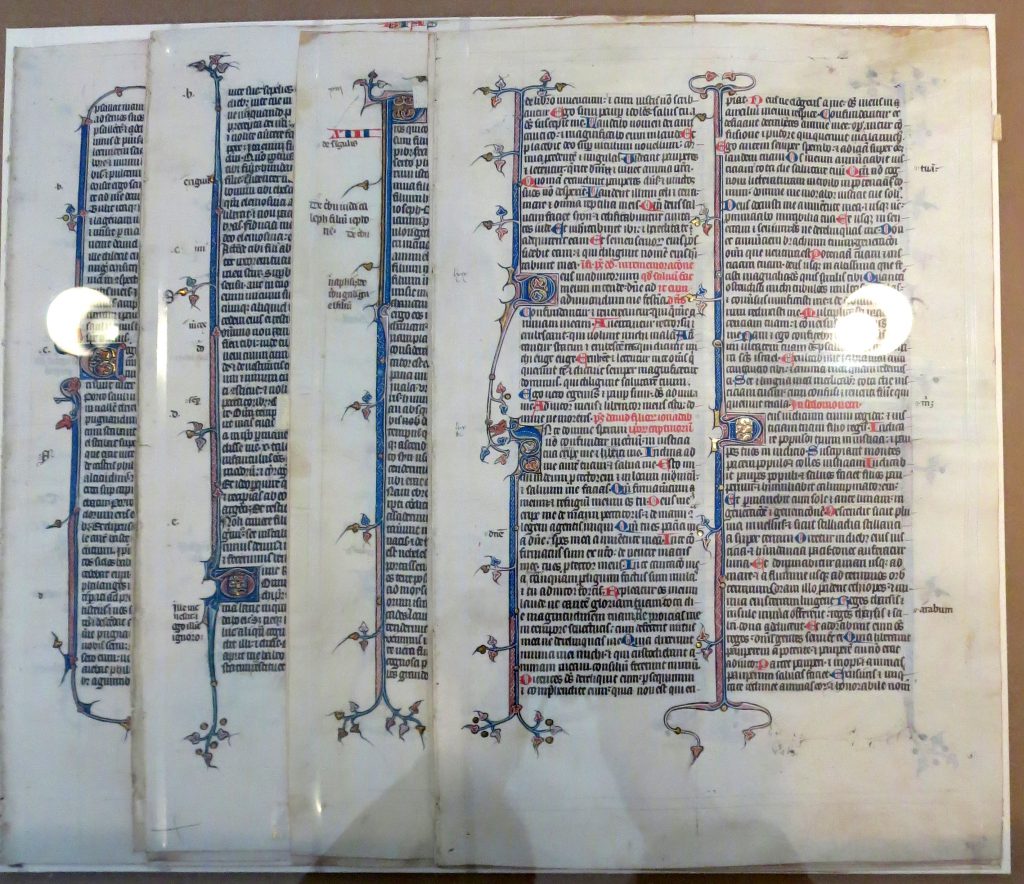
Beinecke Rare Book & Manuscript Library, Otto Ege Collection, MS 14 Segments, with recto for Psalms 68:28 – 71:14 on top.
Segments of Leaves from left to right
Segment 2.1: 1 Samuel 16:16 ([spiritum dei /] psallat manu) – 17:10 in column a on a recto (seen in part here)
Segment 2.2: Tobias 4:5 ([compleverit tempus /] uite sue) – 5:4 in column b on a verso (seen in part)
Segment 2.3: Numbers 13:1 ([est Maria /] Profectus est) – 13:29 in column a on a recto (seen in part)
Segment 2.4: Psalms 68:29 ([deleantur /] de libro) – 71:14 (honorabile non [/ eorum coram]) on a recto (seen in full)
Some Known Remnants
Here follows an updated, but still partial, list of the Remnants, based on some materials to hand. The identifications of textual contents offer corrections for the published reports of a few leaves.
Please note that this list is not complete, even for the records that I know about, let alone the ones yet to emerge into view. For example, some of the sales catalogues remain elusive, but they may surface.
In this list, the order of the scattered leaves from the Books of the Bible mostly follows the standard Vulgate edition, but their order in the manuscript seems to have differed somewhat. Where it differs, the actual order can be determined, at least in part, by the Known Folio Numbers (see above) and the text on some survivors which end one Book of the Bible and begin another. A case in point here is the leaf which begins Paul’s Epistle to the Hebrews, directly followed by the Acts of the Apostles.
I cite all the Known Numbers as locators in the series, even where the survival of those very leaves might remain uncertain. For emphasis, they are shown in *red, together with their asterisk. In the analysis following this list, any conjectured, rather than recorded, folio numbers are preceded by a question mark, also in the red (?*300). As I hope you might see, keeping track of these details has a purpose, sometimes (as here, hurray) with a payoff.
It is useful to track leaves according to their “find-place” or distribution method, that is:
- in an individual numbered Set of Ege’s Portfolio of Fifty Original Leaves of Western Manuscripts (“FOL”), in which the specimens from this dismembered Bible are Leaf number 14, set in a windowed frame and accompanied by a printed label
- as a “stray” or “Rogue” Leaf distributed on its own, with or without a mat and a label, or with a pencil description by Ege in the lower margin
- as a “Residual” batch of multiple leaves (sometimes with the binding or a part of it) seemingly left over from the phases of disbinding, selling, and distributing leaves in the Portfolio sets, in the matted frames, or in loose-leaf form
Complete Vulgate Bible
accompanied by Prologues
and the Glossary of Interpretationes Nominum Hebraicorum
Several sellers or collections list groups of leaves which include, or might include, non-consecutive leaves and/or leaves acquired at different times from different sources. Sometimes they cite the contents in some detail, sometimes not.
Examples include non-continuous leaves listed in a single lot number, gathered in a single collection, or grouped in a large batch in a single collection. As here:
- 3 non-continuous Rogue Leaves = Gwara Handlist 14.9.
Metropolitan Museum of Art = William D. Wixon et al., Mirror of the Medieval World (1999), pages 118–119 (number 141),Leaves ‘1’, ‘2’, and ‘3’,
with Portions respectively ofEzdra > Nehemiah [?]
Joshua
Ephesians 1:1 – 2 - 102 Residual Leaves = Gwara Handlist 14.7.Oslo and London, The Schøyen Collection, MS 223.
Its full contents are not known to me.
Requests for further information have yielded no details.The specimen image on the collection’s website shows a detail of the page withPaul’s Epistle to Philemon and the beginning of his Epistle to Hebrews
A Preliminary Reconstruction of the Original Sequence of Leaves
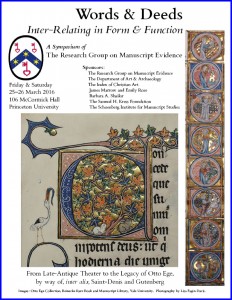
2016 ‘Words & Deeds’ Symposium Poster.
Here I list the contents in their Biblical places, insofar as they are revealed. Some leaves do not have available photographs, or available photographs for the other side (whichever side of the leaf that might be). Some leaves I know only through the sales catalogues, not their destinations.
This list represents an advance on the earlier version posted in my first post on parts of this manuscript: A New Leaf from ‘Otto Ege Manuscript 14’. Here, by gathering my notes and photographs from on-going research on Ege manuscripts and other materials, the list might accompany others’ reconstructions based on their familiarity with other collections.
Thanks are due to scholars, collectors, curators, and students, including Barbara Shailor, Giles Constable, Lisa Fagin Davis, Raymond Clemens, Diane Ducharme, Peter Kidd, Joshua Benaer, the staff at the Morgan Library & Museum, Kent State University Library, the Cincinnati Public Library, and many others.
Important discoveries have emerged in the past several years. Examples include the deposit of the Otto Ege Collection at the Beinecke Rare Book & Manuscript Library of Yale University and the beginnings of its detailed study. A report on some of its features appeared in the Research Group Symposium on ‘Words & Deeds’ in March 2016, with illustrations from Ege MS 14 on the Posters and in the Symposium Booklet.
With generous permission, I have been able to consult some parts of that Collection in visits to New Haven, in connection with the symposium celebrating it and subsequently. While continuing to wait for the Collection to be catalogued and made accessible for outside readers, I examine my photographs as records or glimpses of parts of its materials for, and from, ‘Otto Ege Manuscript 14’. Recently, the work by Joshua Benaer on the lection marks and their signifcance has inspired me to advance with work on other aspects of the book, including its material evidence.
Some discoveries for the manuscript are reported in our blog.
- Updates for Some ‘Otto Ege Manuscripts’ (Ege MSS 8, 14, 41, and 61)
- Some Leaves in Set 1 of ‘Ege’s FOL Portfolio’ (Ege MSS 8, 14, 19, and 41)
See also The Illustrated Handlist (Number 4).
Note that Leaf 4 at Stony Brook University has a ‘starring role’ in the video of Unscattered Leaves: Digitizing the Otto F. Ege Manuscripts (2018).
The Former Bindings
See below.
The Manuscript Leaves
According to the Beinecke exhibition label for parts of this “Lectern Bible” (see above), a note entered “at the end of this Bible”, written by “a later hand”, states it had “502 folios”. It is not clear (at this distance) if the count included any endleaves apart from the original medieval manuscript. The leaves themselves are not numbered, apart from some quire-numerals.
The Sotheby’s sale catalogue of 1931 for this book, while intact, cites 15 specific folio numbers for some significant decorative elements, and adds “B” to the number to indicate a verso. Here I indicate them in red. Although those numbers do not appear on the leaves themselves, they locate 10 historiated initials — among a total of “Seventy-eight large miniatures” — in these places: folios 46 (Book of Numbers), 155 (II Chronicles), 191 (Judith), 220 (Psalm 54), 253 (Ecclesiasticus), 266B (Isaiah), 308B (Ezekiel), 345B (Nahum), 440 (Acts of the Apostles), and 457 (Apocalypse).
Old Testament with Prologues
Prefatory Texts
Jerome’s Prologues for the Vulgate Bible and the Pentateuch
The Bible opens with 2 of Jerome’s epistolary Prologues for his Vulgate Version. His Epistle to Paulinus, Bishop of Nola, serves as a general preface, beginning Frater ambrosius tua mihi minuscola preferens. Beginning Desiderii mei desideratas accepi epistulas, Jerome’s Epistle to Desiderius serves as preface to the Pentateuch, the first 5 Books of the Old Testament.
These prefatory texts spread across 3 leaves.
Rogue Leaf (1 of 2 from the Esther Rosenbaum Collection).
Sotheby’s, Catalogue of Single Leaves and Miniatures from Western Illuminated Manuscripts, 25 April 1983, lot 83(a), without plate
— described in the catalogue as the
- ‘Opening leaf of the Bible, with the [First] Prologue of St. Jerome’ beginning Frater Ambrosius,
and extending to labiis personaret, ‘which shows the secundo folio to have begun’ with the words ignorabat eum
Location unknown
- [1 leaf in this Prologue, with the text from ignorabat eum in Chapter ‘VI’ to et regna in Chapter ‘VII’]
Rogue Leaf = Gwara Handlist 14.8. Randolph College (available via the Internet Archive)
Part of Jerome’s 2 Prologues to the Vulgate Bible (that is, 2 of his own Epistles applied to his translated work as guides and explications):
- Part of Frater Ambrosius, from within Chapter ‘VII’ (omnia subvertentem) to the end,
all of Jerome’s [Second] Prologue Desiderii mei,
and Opening Title for the Book of Genesis
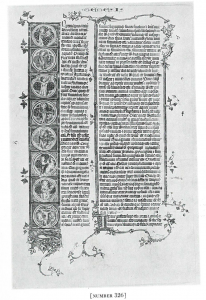
Photograph Courtesy of Sotheby’s, Inc. © 29 November, lot 326, plate on page 118
Old Testament with Prologues
Beinecke Rare Book & Manuscript Library, Otto Ege Collection
- Opening of Genesis on a recto
The recto was reproduced as the fold-out plate for the Sotheby’s catalogue of 6–7 July 1931, lot 389;
and as the first of two plates for the Parke-Bernet catalogue of 29 November 1948, lot 326 (plate on page 118)
— in both cases while the manuscript remained whole.
The plate from the Parke-Bernet catalogue is also reproduced in Gwara, Otto Ege’s Manuscripts, figure 79.
The leaf disappeared from view until resurfacing in the Otto Ege Collection, Beinecke Rare Book and Manuscript Library, Yale University.
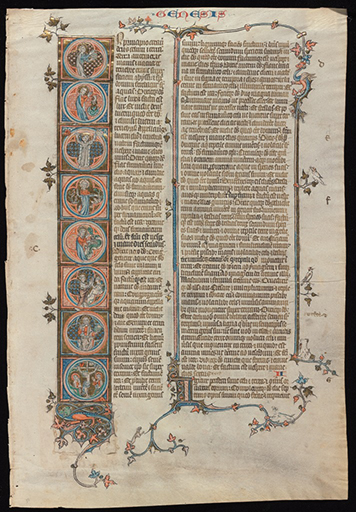
First page of Genesis from ‘Otto Ege MS 14’. Otto Ege Collection, Beinecke Manuscript and Rare Book Library, Yale University. Reproduced by permission.
Verso
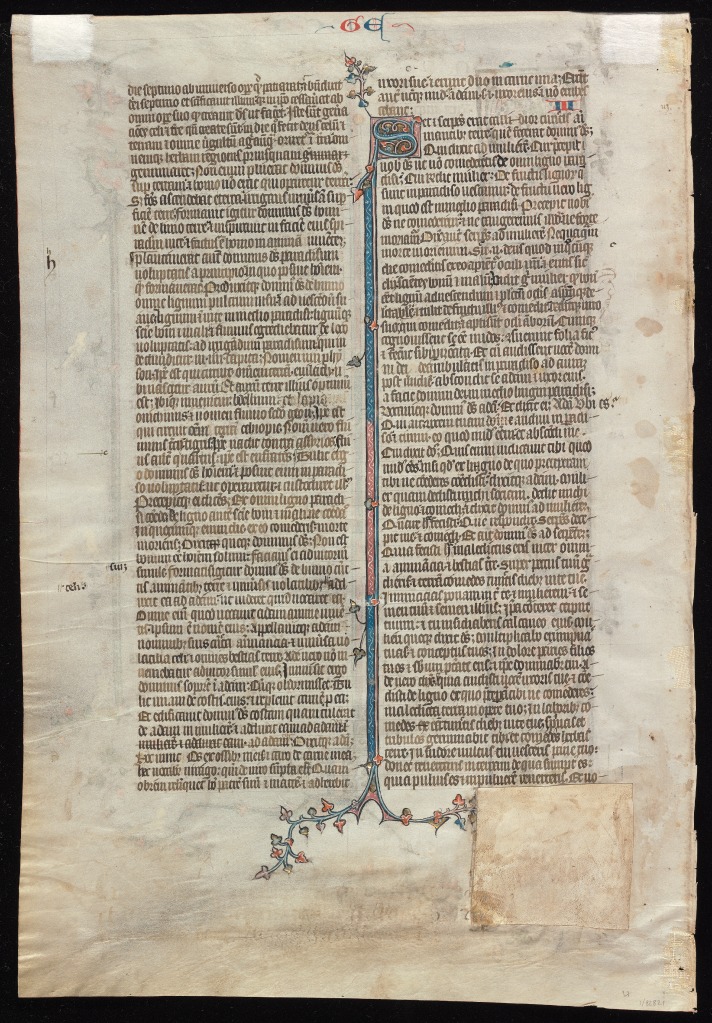
Beinecke Rare Book & Manuscript Library, Otto Ege Collection, MS 14, Genesis Opening Leaf: Verso.
Rogue Leaf. Maggs Bros, Papyrus to Paper. Catalogue 1059 (1985),
number 49, ‘a leaf with four dragons’ (with plate on page 28, of top half of verso)
- Genesis 32:29 ([interroga–/]uit to 34:6 and beyond in the lower half of that verso (out of frame in the plate)
Rogue Leaf. Maggs Bros, Papyrus to Paper. Catalogue 1059 (1985), number 42 (no plate)
- Genesis ‘end ch. 42, ch. 43 & most of ch. 44’ with ‘drawing of a rabbit with calligraphic flourishes’ in the upper margin of the recto
Location unknown: Rogue Leaf (2 of 2 from the Esther Rosenbaum Collection)
Sotheby’s, Catalogue of Single Leaves and Miniatures from Western Illuminated Manuscripts, 25 April 1983,
lot 83(b), with plate from the upper part of one side (unspecified)
- including the Prologue to Exodus and the opening of Exodus 1 with historiated initial
Rogue Leaf (3 of 3) sold by Bruce P. Ferreni, Catalogue One: Important Western Medieval Illuminated Manuscripts & Illuminated Leaves (1987),
number 27 (page 44), without plate
- Exodus 9 – 14
Location unknown
[Update: Identified as having been “bought by Berés. Photos at the Conway Library, Courtauld Institute of Art.” Peter Kidd, The McCarthy Collection, Volume III: French Miniatures (London: Ad Illissvm, 2021), no. 60, pp. 199-202, at pp. 201–202 note 5.]
[Update: Now see Two Old Testament Leaves from ‘Otto Ege Manuscript 14’ at Smith College.]
- Leviticus
Location unknown
- [Numbers initial = folio *46r]
Beinecke Rare Book & Manuscript Library, Otto Ege Collection
- “Segment 1.3” (see photograph): Numbers 5:18 ([cum execra-/]tione)– 6:26 (convertat dominus [/ ultum sum]), plus catchwords (ultum sum) at the bottom, on a verso (seen in full in the “New Acquisitions” exhibition display as “Stack 1 Segment 3”)
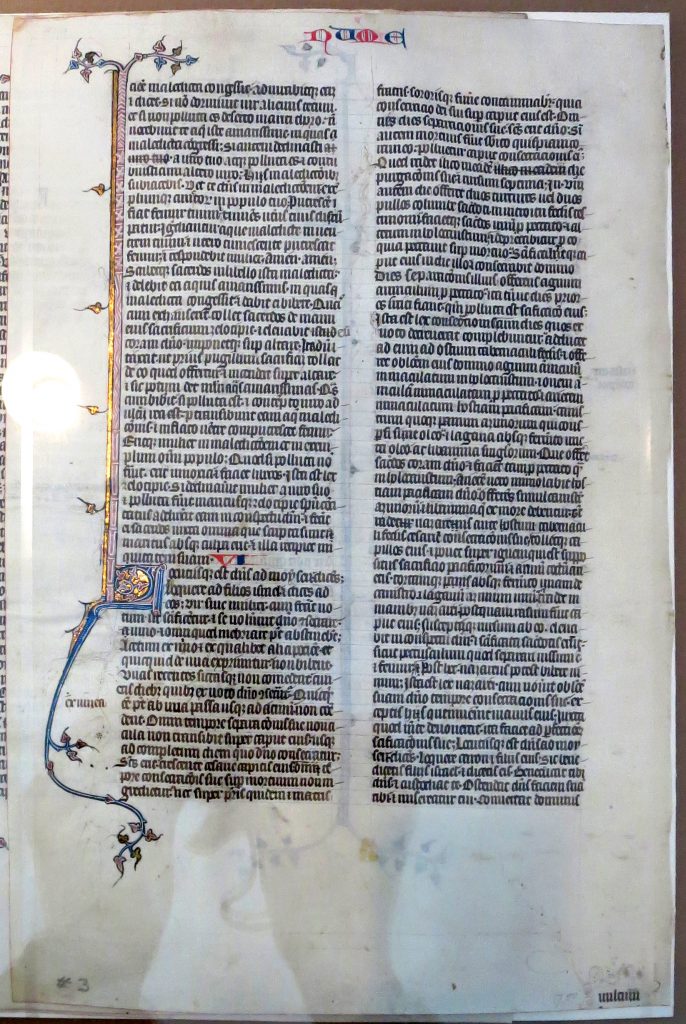
Beinecke Rare Book & Manuscript Library, Otto Ege Collection, “New Acquisitions Exhibition”, Ege MS 14: Recto of Leaf from the Book of Numbers (5:88 – 6:26).
Beinecke Rare Book & Manuscript Library, Otto Ege Collection
- Leaf with Numbers 13:1–29 in column b on a verso (partly visible in the “New Acquisitions” exhibition display as Stack 2 Segment 3 = 3rd from the left)

Beinecke Rare Book & Manuscript Library, Otto Ege Collection, MS 14 Segments, with recto for Psalms 68:28 – 71:14 on top.
Set 27. University of South Carolina, reproduced also here
- Numbers 8.10 (suas) – 11.13 (ut co-[/medamus])
Beinecke Rare Book & Manuscript Library, Otto Ege Collecdtion
- ‘Segment 2.3’ (photograph above): Numbers 13:1 ([est Maria /] Profectus est) – 13:29 in column a on a recto (seen in part)
Rogue Leaf (1 of 2). Sotheby’s, Western Manuscripts and Miniatures (21 June 1994), lot 10(a.1), without plate
- Numbers 19–21
Set 19. Otto F. Ege: Fifty Original Leaves, Leaf 14, Special Collections and University Archives, Stony Brook University Libraries
- Deuteronomy 17:14 ([dabit ti-/]bi et possideris) – 20:19 (nec per circuitam se[sic for de-][/bes vastare])
Recto of leaf
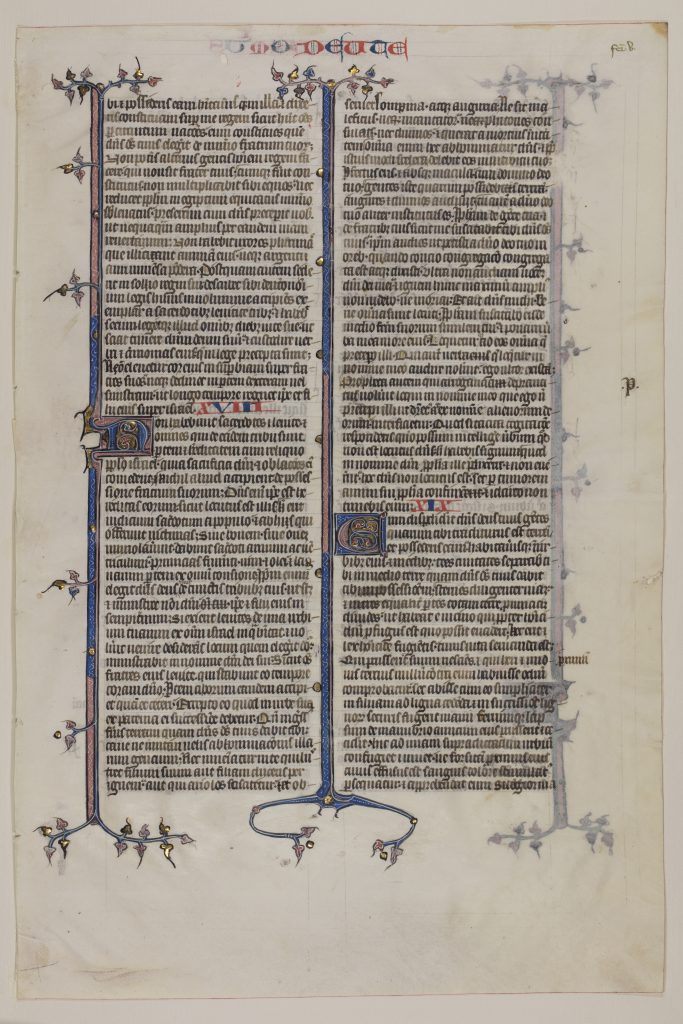
Otto F. Ege, “Fifty Original Leaves”, Leaf 14 recto, Special Collections and University Archives, Stony Brook University. Image Public Domain.
Verso of leaf
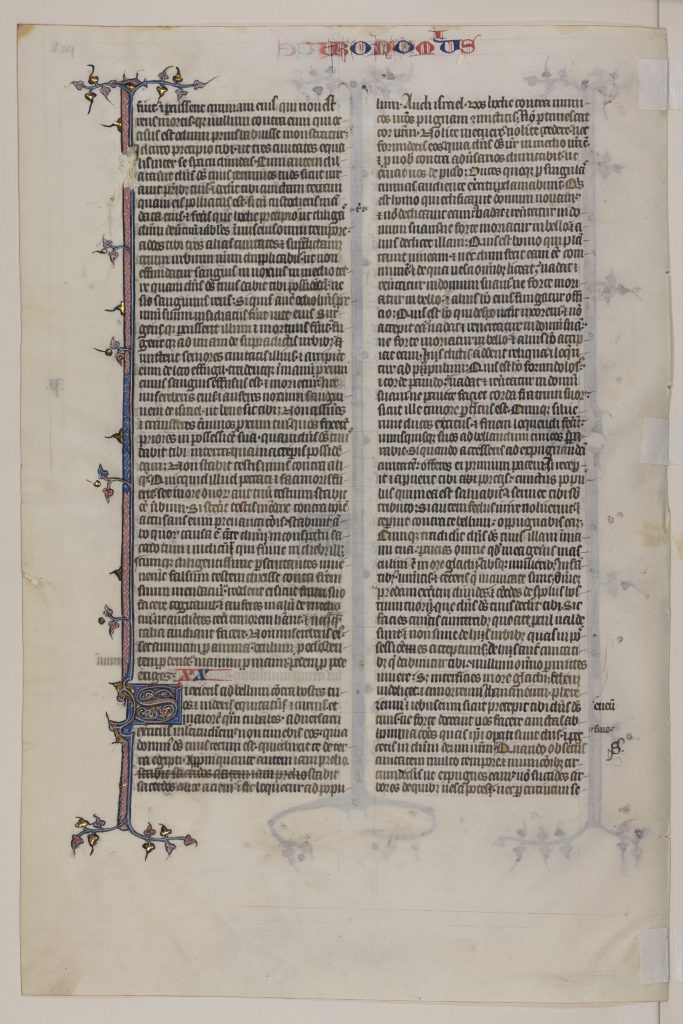
Otto F. Ege, “Fifty Original Leaves”, Leaf 14 verso, Special Collections and University Archives, Stony Brook University. Image Public Domain.
Spectator Included
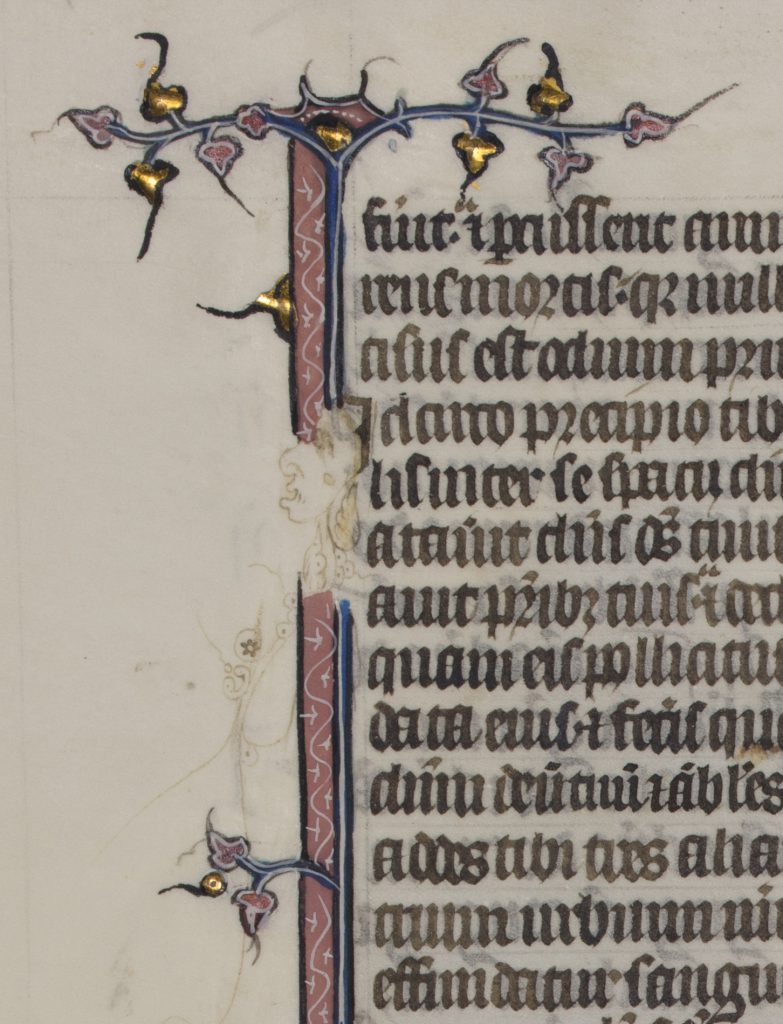
Otto F. Ege, “Fifty Original Leaves”, Leaf 14 verso, detail top left. Special Collections and University Archives, Stony Brook University. Image Public Domain.
Location unknown
- [Joshua initial = folio *73v]
[Update: See A Leaf in Dallas from ‘Otto Ege Manuscript 14’.]
Rogue Leaf (2 of 3) = Gwara Handlist 14.9. Metropolitan Museum of Art. 1994.539
= Wixom et al. (1999), no. 141, Leaf ‘3’ with plate on page 119, column b
- Joshua 8:32 ([la-]/pides] – 10:1 (sicut enim fecerat) on verso
Location unknown
- Judges
[Update: See A Leaf in Dallas from ‘Otto Ege Manuscript 14’.]
Location unknown
- Ruth
Location unknown
- [Prologue initial for I Kings (1 Samuel) = folio *93r]
Beinecke Rare Book & Manuscript Library, Otto Ege Collection
- “Segment 2.1” (photograph above): 1 Samuel 16:16 ([spiritum dei /] psallat manu) – 17:10 in column a on a recto (seen in part)
Rogue Leaf. RMGYMss Bible Leaf Ref 560: RMGYMss BIBLE LEAF Ref 560 recto and RMGYMss BIBLE LEAF Ref 560 verso
- I Kings (1 Samuel) 26:7 ([et Abi-/]psae ad populum nocte) – end of 28:25 (noctam illam [/ Congregata sunt])
Location unknown
- II Kings (2 Samuel)
Rogue Leaf. RMGYMss Bible Leaf Ref 180
- III Kings 11:20 ([et nutrivit /] eum ahias) – end of 13:15 (comedas panem [/qui ait])
Rogue Leaf = Gwara, Handlist 14.1.
Boston University = Judith H. Oliver, Manuscripts Sacred and Secular (1985), number 36 [but no plate]
- End of Kings, Prologue to I Chronicles, and beginning of I Chronicles
with a ‘patch taken from another illuminated page of the same manuscript’ covering the cut-out from the ‘theft of initial for I Chronicles’.
[One wonders which other page yielded its riches to patch up this leaf.]
2 Rogue Leaves = Gwara Handlist 14.10. Hollins University
These leaves include
- a page with the End of I Chronicles, Prologue for II Chronicles, and beginning of II Chronicles
[= folio *155r]
(reproduced in Gwara, Otto Ege’s Manuscripts, figure 51)
Rogue Leaf. Stanford University
[Formerly available at http://artsinstitute.stanford.edu/sites/scriptingthesacred/gallery/case-bible/ via Stanford Arts Institute],
purchased from Bernard Quaritch, Medieval Manuscripts. Catalogue 1396 (2010),
number 10, with color plate of recto
- II Chronicles 4:12 ([episty-/]lia) – 6:10 (super thronum Israhel)
with quire number xiiii on bottom of the recto
[= say folio ?*157, as reckoned below]
Set 13. University of Minnesota
- Prayer of Manassas Chapter 15 (quoniam),
Prologue to I Ezra,
I Ezra 1:1 – 2:62 (eiecti sunt)
Rogue Leaf (1 of 3) = Gwara Handlist 14.9. Metropolitan Museum of Art
= Wixom et al. (1999), no. 141, Leaf ‘1’ with plate on page 118, column a of one side of the leaf (unspecified)
- Ezdre I > Ne[he]miae as indicated in the running titles
I Ezra 10:13 (in sermone) – 44 (end),
beginning of II Ezra [= Ezra 11:1–10 (manu tua)] on one side of the leaf
Rogue Leaf. Maggs Bros, European Bulletin 13 (1986), number 52 (with plate of lower half of recto)
- Nehemiah 5:18 – 7:3 (porte clausae) on that portion of the page
Beinecke Rare Book & Manuscript Library, Otto Ege Collection
- “Segment 2.2” (photograph above): Tobias 4:5 ([compleverit tempus /] uite sue) – 5:4 in column b on a verso (seen in part)
Location unknown
- [Judith initial = folio *191r]
Set 30. Denison University
- Judith 16:31, Jerome’s Prologue to Esther, and Esther 1:1–2:19
Beinecke Rare Book & Manuscript Library, Otto Ege Collection
- “Segment 1.1” (see photograph above): Esther 2:19 ([Mordocheus manebit /] ad regis) – 3:8 in column a on a recto (seen in part)
Rogue Leaf. formerly Boston, Endowment for Biblical Research = Judith H. Oliver, Manuscripts Sacred and Secular (1985), number 35, without plate
- Job 31:1 – 33:20
Location unknown
- [Psalms 54 initial = folio *220r]
Beinecke Rare Book & Manuscript Library
- Psalms 68:29 ([deleantur /] de libro) – 71:14 (et honorabile nomen [/ eorum cora]) on the recto
Viewed while on exhibition (Top leaf here = “Segment 2.4”):

Beinecke Rare Book & Manuscript Library, Otto Ege Collection, MS 14 Segments, with recto for Psalms 68:28 – 71:14 on top.
Parke-Bernet Galleries, Sale Catalogue of 29 November 1948, lot 326, plate (apparently a verso): Psalms 109 initial (“Holy Trinity”)
- Psalms 108:13 (generatione) – 112:4 (do-[/mine super caelos]) on the verso
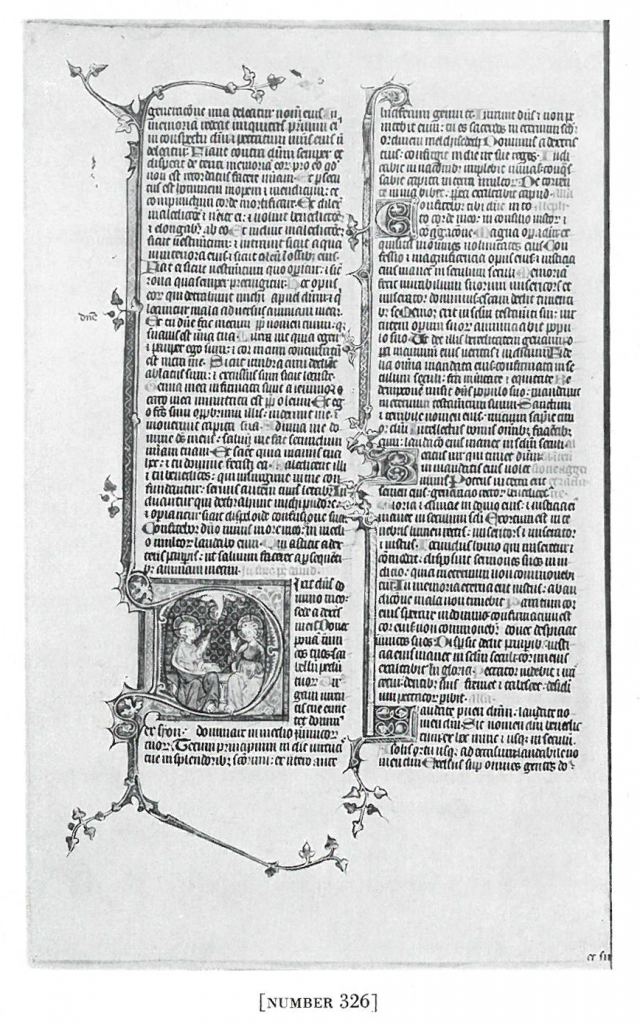
Psalms 108:13 to 112:4 on a verso. Photograph Courtesy of Sotheby’s, Inc. © 29 November, lot 326, plate on page 119
[Maybe here in the original sequence?]
Rogue Leaf. Christie’s, Illuminated Manuscripts, Continental and English Literature . . . ,
Sale Catalogue of 16 December 1991, lot 2, plate on page 14 with detail of initial (on a verso?)
- Proverbs (Book of Wisdom) initial 1:1 (full span of leaf unreported)
Beinecke Rare Book & Manuscript Library, Otto Ege Collection
- “Segment 1.2” (see photograph above): Proverbs 13:22 ([et ne-/]potes et) – 14:28 in column a on a recto (seen in part)
Location unknown
- [Ecclesiasticus initial = folio *253r, reproduced in the Sotheby’s 1931 Catalogue, as reported above]
University of Kansas, Kenneth Spencer Research Library
- Ecclesiasticus 12:16 ([in foream /] in oculis suis) – ([et inter-[rogatio omnium]), with catchword –rogatio
Set 5. Ohio University
- Ecclesiasticus 39:25 – 42:26
Recto
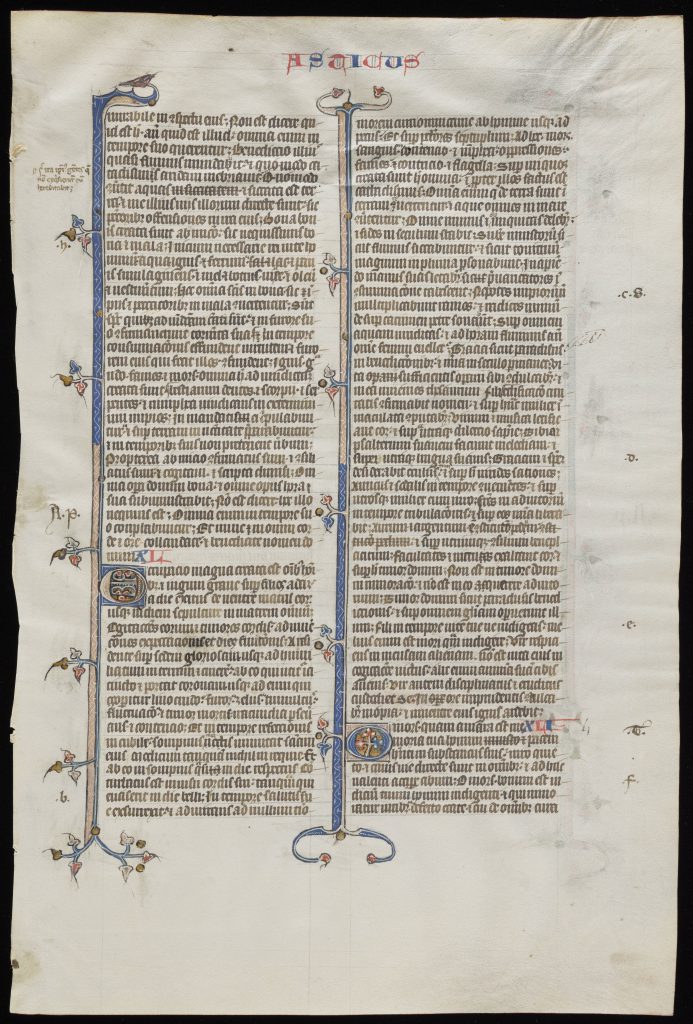
Ohio University, Ege MS 14, Recto. Image Public Domain.
Verso
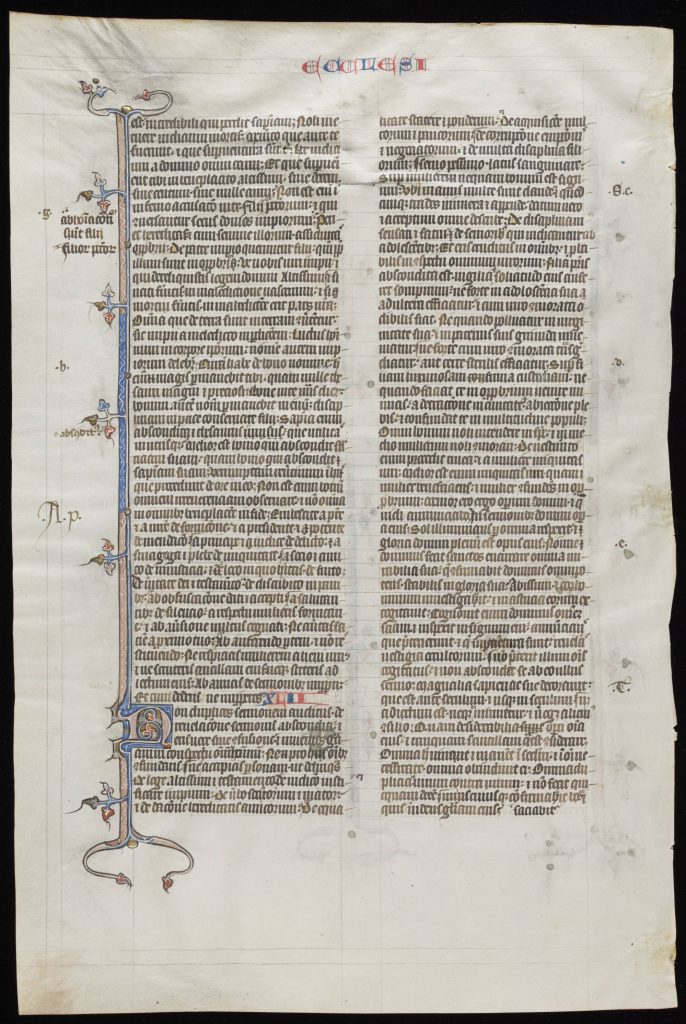
Ohio University, Leaf from Ege MS 14, verso. Image Public Domain.
Location unknown
- [Isaiah initial = folio *266v]
Rogue Leaf (2 of 3) sold by Bruce P. Ferreni, Bruce P. Ferreni, Catalogue One: Important Western Medieval Illuminated Manuscripts & Illuminated Leaves (1987),
number 26 (page 44), without plate
- Isaiah 50 – 54; full span unreported
— These leaves presumably are consecutive
Rogue Leaf for sale via Charles Edwin Puckett
- Isaiah 54:10 ([montes enim /] commovebuntur et) – 59:3 on recto; verso not shown
Set 2. Ohio State University
- Jeremiah 7:27 ([patres eorum /] Et [with tamen crossed out] loqueris) – 10:11 (caelis sunt [/ Qui facit])
Set 24. Lilly Library
- Jeremiah 37:20 (Ieremias in uestibulo) – 40:15 (peribunt)
Rogue Leaves. Bifolium with non-consecutive leaves at the Cleveland Museum of Art
- Leaf 1, recto?
verso. End of Baruch 6: 6:61 ([perficiunt quod /] imperatum est),
Jerome’s Prologue to Ezekiel,
Ezekiel 1.1 – 13 (et quasi aspec-[/tus lampadarum]) on verso
[= folio *308v]
> Location unknown
Leaves between Ezekiel 1:13 ([aspec-/]tus lampadarum) and Ezekiel 8:2 (et ecce [/ similitudo quasi])]
- Leaf 2, recto. Ezekiel 8:2 ([et ecce /] similitudo quasi) – 9:9 (habebat attramentarium [/ in dorso])
on the verso?
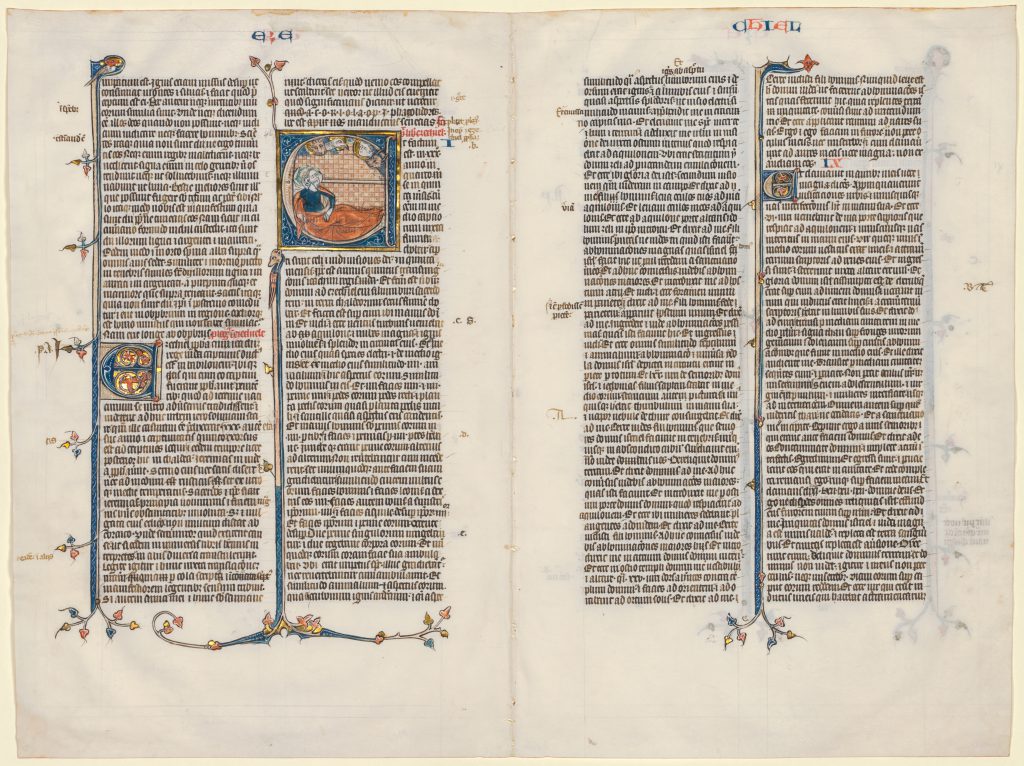
Cleveland Museum of Art, Bifolium from a Bible: (Ege MS 14), with parts of Ezekiel,via https://clevelandart.org. /art/1959.271. Image Public Domain via Creative Commons..
[Update: Now see Two Old Testament Leaves from ‘Otto Ege Manuscript 14’ at Smith College.]
Set 35. Rochester Institute of Technology
- Ezekiel 18:21 – 20:11 (recto).
verso: ‘A scan of the verso is not currently available.’
Set 38. University of North Carolina at Greensboro
- Ezekiel 24:25 ([et di-/]siderium oculorum eorum) – 27:30 (et clamabunt [/ et superiacient])
— These 2 leaves are consecutive
Set 37. Case Western Reserve
- Ezekiel 27:30 ([clamabunt /] amare) – 30:20 (in un-[/decimo])
Set 32. University of Colorado at Boulder, recto and verso
- Ezekiel 33:31 ([ingrediatur popu-/]ulus meus) – 35:3 (meam [ / super te])
Set 1. Private collection. See Some Leaves in ‘Set 1’ of Ege’s FOL Portfolio
- end of Jeremiah (52:21 ([quattuor de-/]gitorum) to 52:34) and Lamentations 1:1 – 2:19 (qui defecerunt [/ in fame])
Recto of leaf
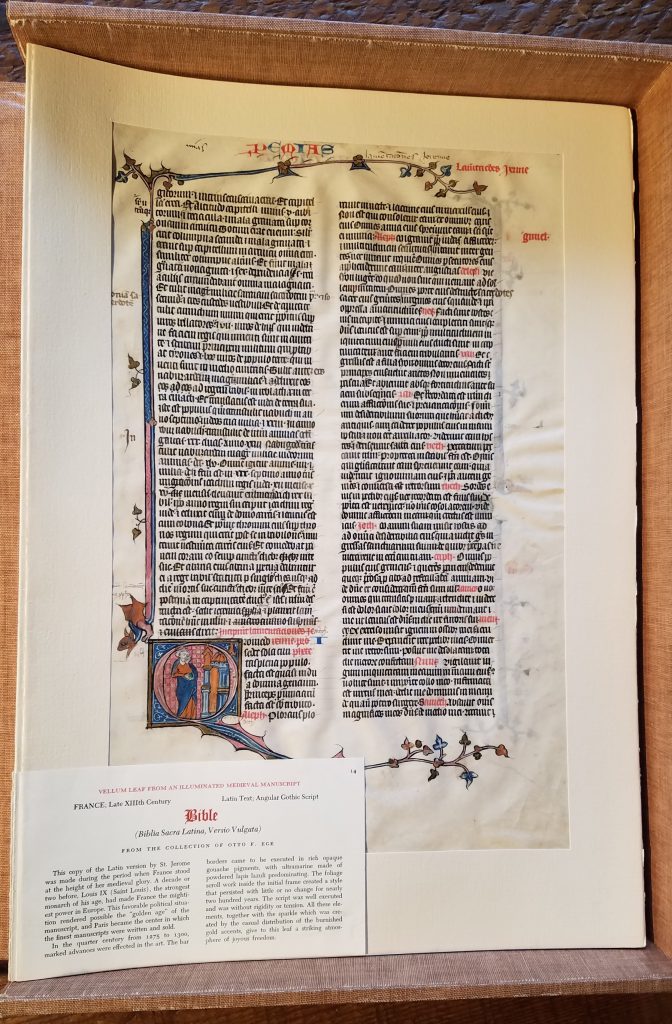
Set 1 of Otto Ege’s FOL Portfolio, Leaf 14 recto.
Verso of leaf
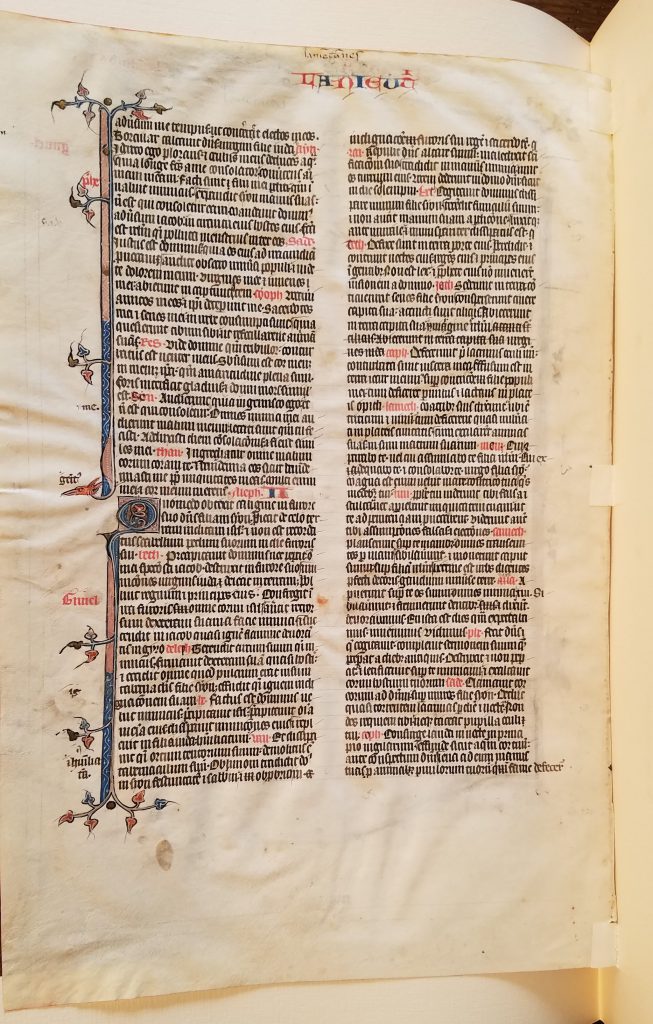
Set 1 of Ege’s FOL Portfolio, Leaf 14 verso.
Set 4? [Or a Rogue Leaf?]. Cleveland Museum of Art
- End of Prologue 1 to Jonah [Sanctum ionam . . . et quo /] a facie tua fugiam], all of Prologue 2 to Jonah (Iona[s] columba . . . ),
all of Jonah (1:1–4:11),
Prologue to Michah, and Michah 1:4 (vales scindentur [/ sicut cera])
Recto of Leaf
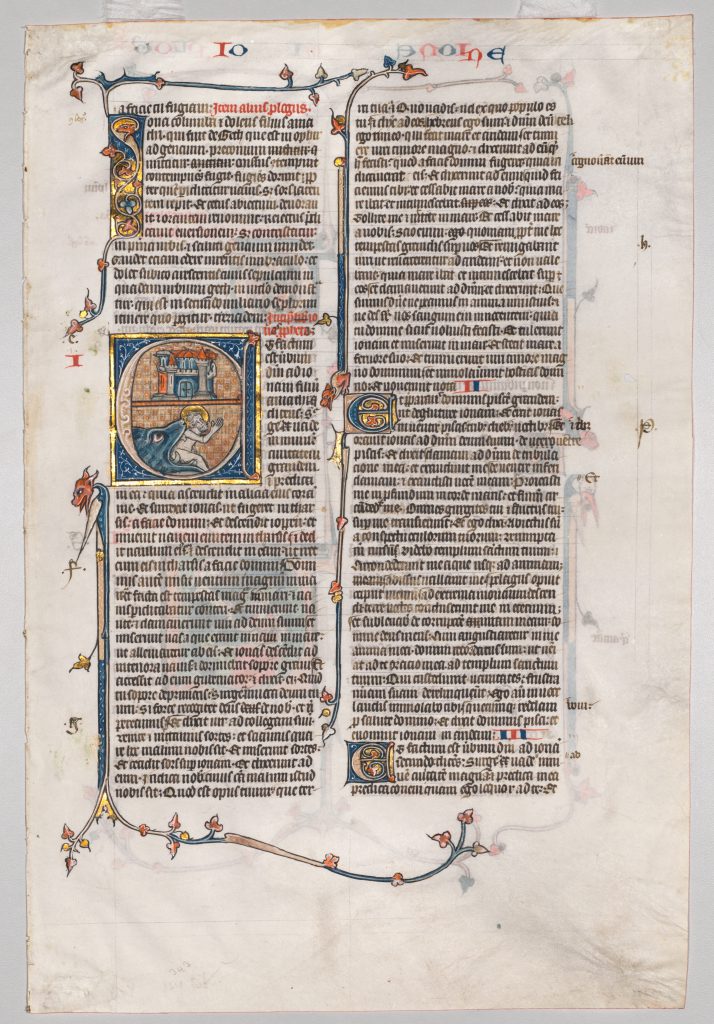
Cleveland Museum of Art, Single Leaf from a Bible: Initial E with Jonah Swallowed by the Whale via https://clevelandart.org. /art/1959.271. Image Public Domain via Creative Commons.
Verso of Leaf
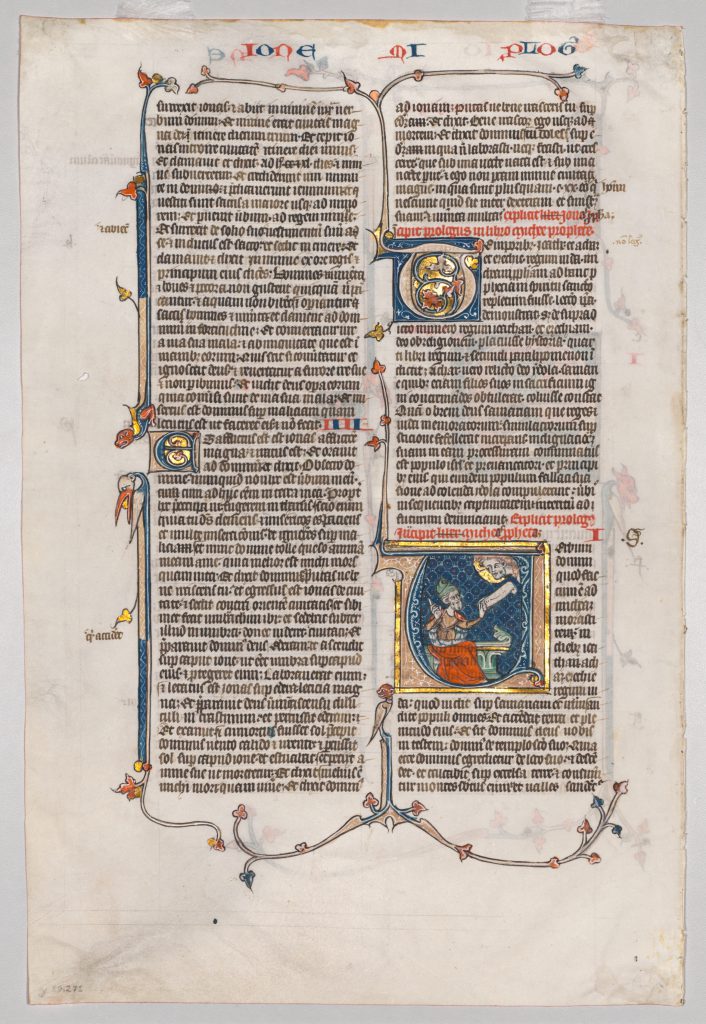
Cleveland Museum of Art, Single Leaf from a Bible: Initial U of Uerbum with Prophet Micah, via https://clevelandart.org/art/1959.271. Single Leaf from Ege MS 41, Verso. Image Public Domain via Creative Commons.
— These 2 leaves are consecutive
Set 22. Cleveland Public Library
- Micah 1:4 (sicut cera) – 6:2 (iudicum do-[mini])
— These 2 leaves are presumably consecutive
Rogue Leaf. Maggs Bros, Papyrus to Paper. Catalogue 1059 (1985), number 46 and plate on page 27 with detail of initial
- ‘The final chapter of the Book of Micah and the opening two chapters of the Book of Nahum’,
plus Mirmelus’s inscription in the first person
[Nahum initial = folio *345v]
Rogue Leaf (1 of 3) sold by Bruce P. Ferreni, Catalogue One: Important Western Medieval Illuminated Manuscripts & Illuminated Leaves (1987),
number 25 (page 44), with plate of verso
- Habakkuk 1 (span unreported) – 3, Prologue to Zephaniah (“Sophonias*), and Zephaniah 1:9 (super om-[/nem qui arrogantur])
Set 15. Kent State University
- Zachariah 7:7 ([ad austrum /] et in campestribus) – 11:10 (cum omnibus / [populis]), reproduced here by permission
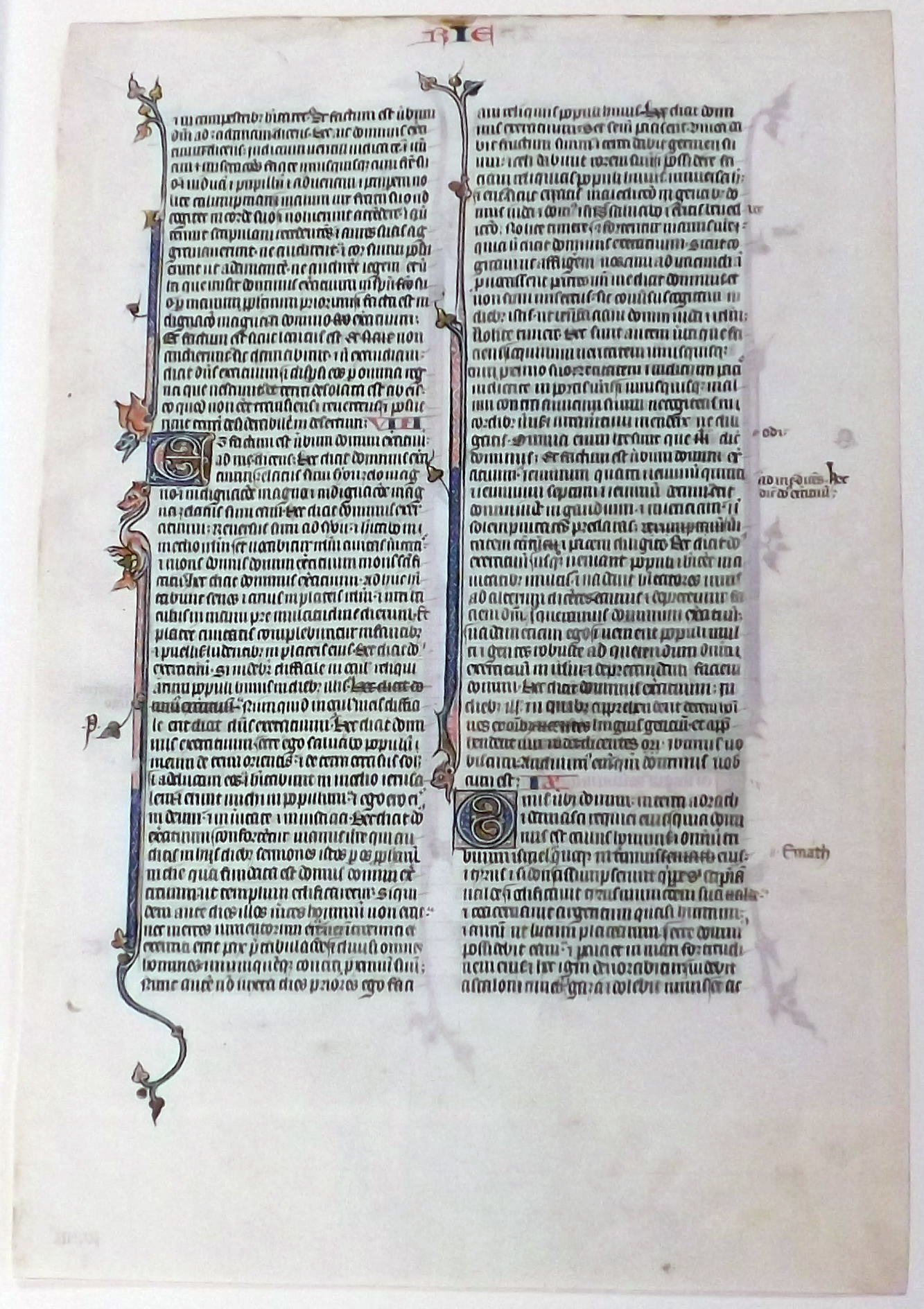
Recto of Rogue Leaf from Ege Manuscript 14 at Kent State University. Reproduced by permission
Rogue Leaf. Kent State University = Gwara, Handlist, Number 14.5
- I Maccabees 12:29 (lumina ardentia) – 14:4 (et quesiuit), reproduced here by permission
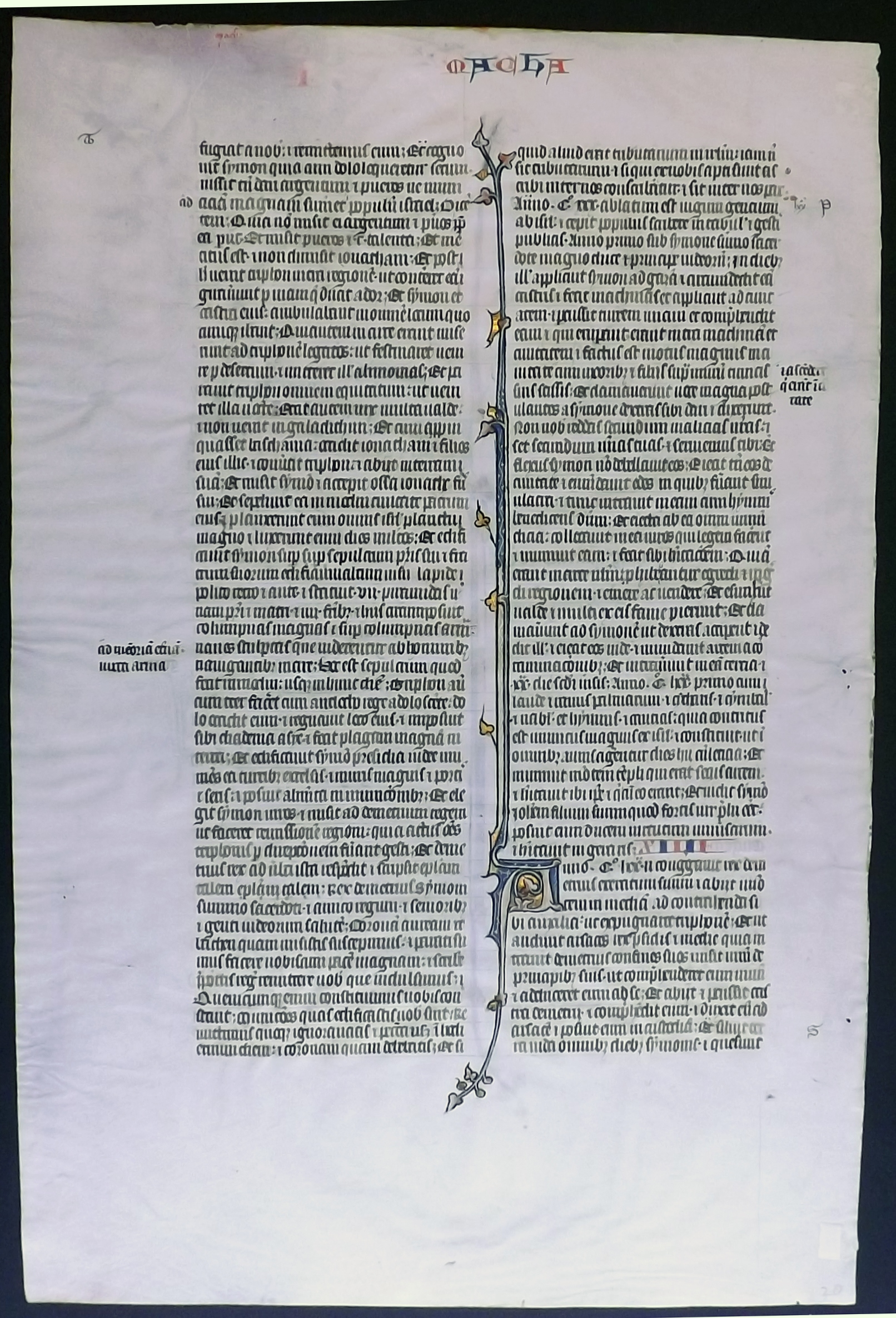
Verso of Rogue Leaf with part of I Maccabees from Ege Manuscript 14 at Kent State University. Reproduced by permission
New Testament with Prologues
Location unknown
- [Gospel of Matthew 10 = folio 388B]
Two details at top and bottom of the page are reproduced in the Sotheby’s catalogue of 6–7 July 1931, lot 389, plate facing the description.The figural elements among the marginal decorations on this ‘one very outstanding page’ without ‘historiated initials of miniatures’, but with a rich repertoire of ‘grotesques’, are described in some detail in the Parke-Bernet catalogue of 29 November 1948, lot 326, page 120.
Set 29. Lima Public Library
- Matthew 27:46 ([Iesus voce /] magna dicens) – 28:19, Prologue to Mark, and Mark 1:1–38 (eamus [/ in proximo])
Location unknown
- Gospel of Mark
Location unknown
- Gospel of Luke
Location unknown
- Gospel of John
Rogue Leaf. Maggs Bros, Papyrus to Paper. Catalogue 1059 (1985),
number 41 with plate on page 22 of top half of the verso
- End of I Corinthians (from 15:56) and Opening of II Corinthians on the portion visible in the plate
[and not the opening of I Corinthians as stated in the catalogue]
Rogue Leaf (3 of 3). Gwara Handlist 14.9. Metropolitan Museum of Art
= Wixom et al. (1999), no. 141, Leaf ‘II’ with plate on page 119, column a]
- Epistle of Paul to the Ephesians, 1:1 – 2:10 (end) plus opening title for Chapter 3 on verso
Among the Residual Leaves = Gwara Handlist 14.7. Oslo and London, The Schøyen Collection, MS 223.
Its full contents are not known to me.
The specimen image on the collection’s website shows part of the page with
- Paul’s Epistle to Philemon and the beginning of his Epistle to Hebrews
[Might these 2 leaves have been consecutive? That depends upon what the verso of the specimen leaf contains.]
Set 6. University of Massachusetts at Amherst (both sides in black-and-white) and recto in color
- Hebrews 1:13 (quando) – 6:20 (aeternum).
Set 23. Kenyon College
- Hebrews 10:20 (iniciauit) – 13:4 (conui-[/bium])
— These leaves are consecutive
Rogue Leaf? Detroit Public Library [?]
- Hebrews 13:4–25, Prologue to Acts, Acts of the Apostles 1:1–30
[Acts initial = folio *440r]
Set 25. University of Saskatchewan and here and here
- Acts 4:1 – 5:11 on verso
Set 9. Cincinnati Public Library
- Acts 13:37 ([quem uero /] deus suscitauit) – 16:2 (et Ychonio [/ fratres hunc])
Recto of leaf
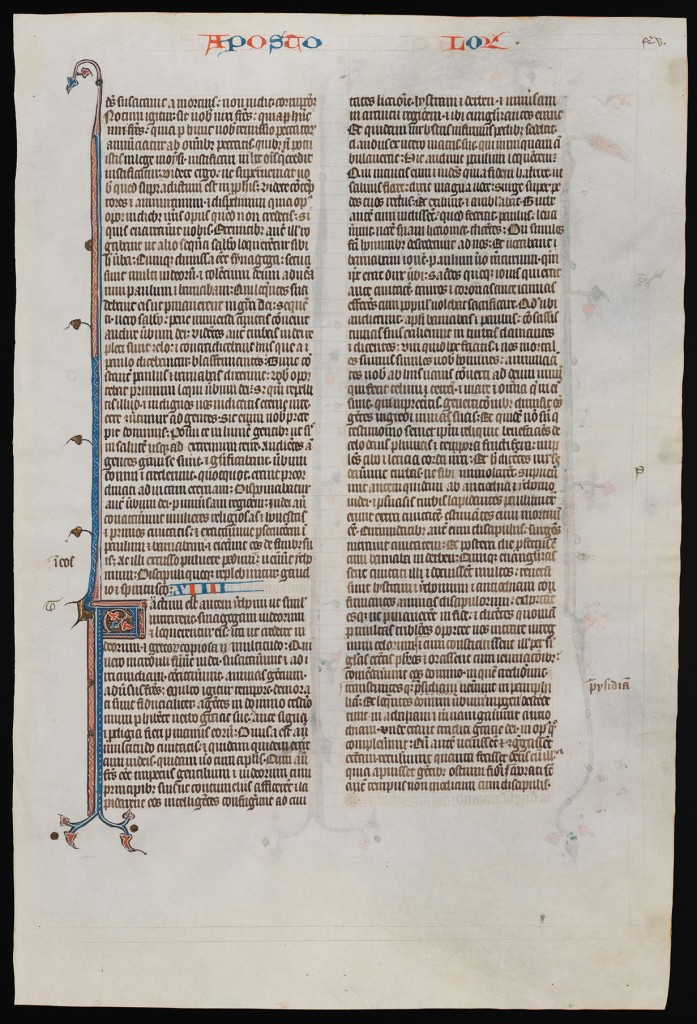
Recto of Leaf 8 in Portfolio Set 9. From the Collection of The Public Library of Cincinnati and Hamilton County. Reproduced by permission.
Verso of leaf
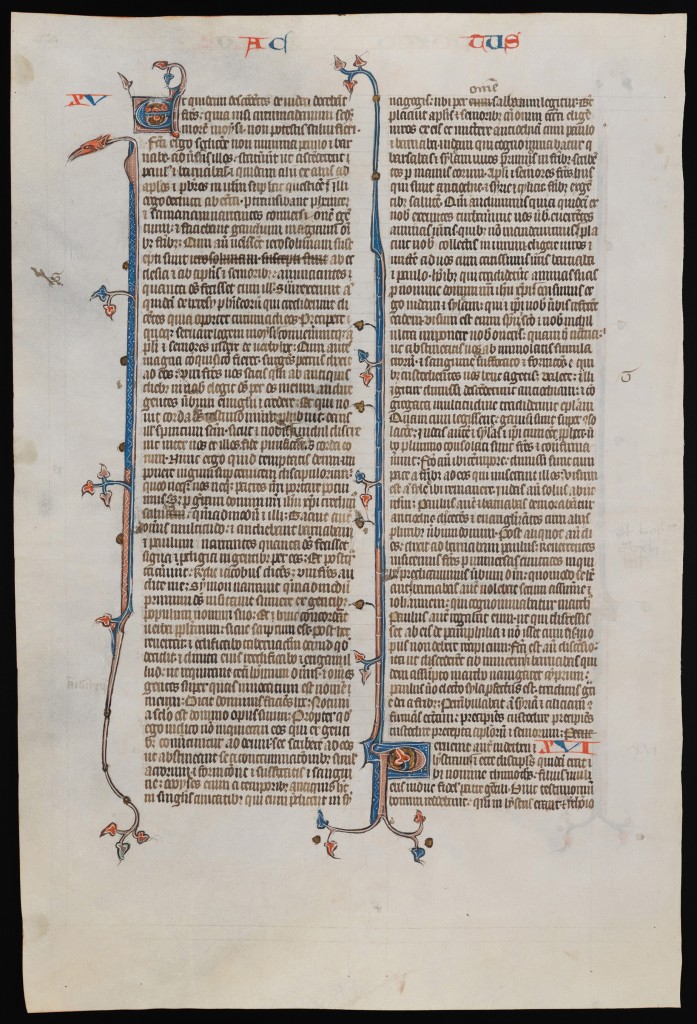
Verso of Leaf 14 in Portfolio Set 9. From the Collection of The Public Library of Cincinnati and Hamilton County. Reproduced by permission.
[Or do the Catholic Epistles follow Acts? If so, maybe they come here in the series?]
Rogue Leaf.
Gwara Handlist 14.Ref 14. Sotheby’s 10 July 2012, lot 2(b)
[Current location unknown to me]
- Opening of the Catholic Epistle of James on verso
described in the Sotheby’s catalogue thus:
(b) leaf from a lectern Bible, 400mm. by 270mm., with a large initial ‘I’ (opening “Iacobus ihesu christi seruus …”, the epistle of James) in burnished gold with a coloured architectural roof and arch, enclosing a bearded James with a golden halo pointing at the opening of his epistle, angular foliage forming text-frame around all sides of one text column, terminating in golden leaves and a dragon, 3-line initial enclosing ivy-leaf, similar text-frame on verso with a dragon and a 5-line initial containing a sprig of foliage ending with a dragon’s head, double column, 50 lines in a regular gothic hand, area of one column cut away (90mm. by 95mm., presumably once with a large initial), now repaired with another cutting from same volume [highlights added], once mounted on card with remains of tape on recto [therefore, turned front-to-back in Ege’s matting to display the verso], France or southern Flanders, early fourteenth century.
Verso:
Part of the Prologue to the Catholic Epistle of James (from [ut quia Petrus /] est primus in ordine apostolorum) and the opening of this Book, with 1:1–2:4 (nonne iudacitis [/ apud vosmet])
* Despoiled Leaf.
Preserved in part on the patch for the Sotheby’s Leaf opening the Catholic Epistle of James (see previous item); perhaps the rest of the leaf is lost?
- Irregularly-shaped Patch containing parts of at least the Catholic Epistle of James 2:8–13 and 3–9 (on one side of the patch)
Rogue Leaf.
Maggs Bros, Papyrus to Paper. Catalogue 1059 (1985), number 44
with plates on pages 24 and 25, respectively of the verso and the top right-hand side of the recto
- End of the Catholic Epistle I of James, all of his Epistles II and III, and the beginning of the Epistle of Jude (to verse 18[+])
Beinecke Rare Book & Manuscript Library, Otto Ege Collection
- End of the Epistle of Jude (from verses 19 (? animales spiritum) to 25)
Prologue to the Apocalypse
Apocalypse 1:1 – 2:10 (coronam vitae [/ verse 11 qui habet])[Apocalypse initial = folio *475r]
Original recto
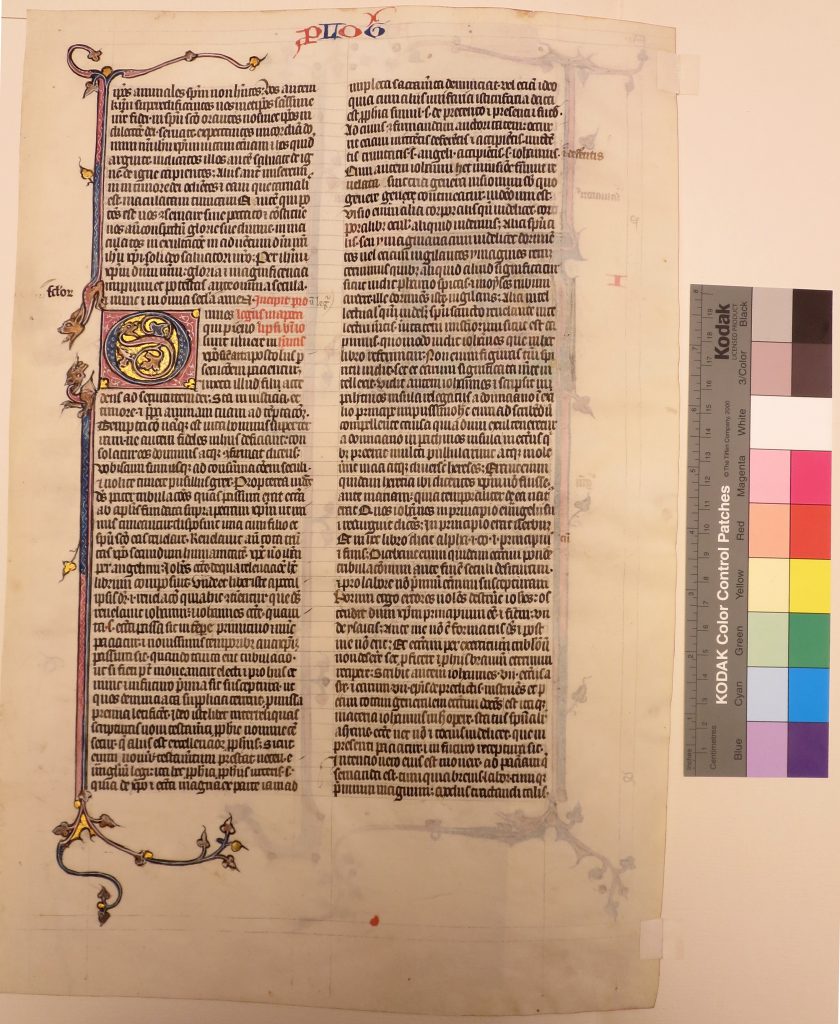
Beinecke Rare Book & Manuscript Library, Otto Ege Collection, Family FOL Portfolio, Leaf 18 ‘verso’. Original recto.
Another view
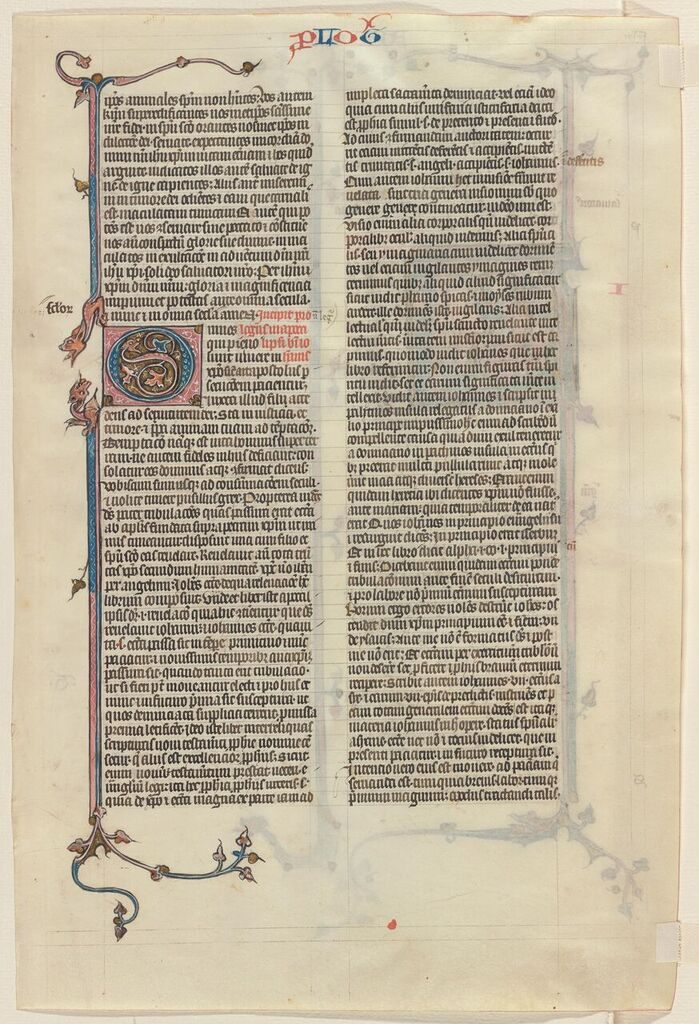
Beinecke Rare Book & Manuscript Library, Otto Ege Collection, MS 14, Apocalypse Prologue Opening Leaf: Original recto.
Original verso

Beinecke Rare Book & Manuscript Library, Otto Ege Collection, Leaf with the opening of the Book of Revelation within Ege’s mat, which turns the original verso to the front.
Set 17. Massey College, recto + verso
- Apocalypse 2:27 (qui habet) – 6:9 (altare)
Interpretation of Hebrew Names
The leaves so far recognized from the Interpretatio Nominorum Hebraeorum (“INH” or “IHN”) for this Bible represent different parts of the partly alphabetized version of this Glossary, beginning Aaz apprehendens (that is, ‘Aaz means “seizing” ‘) — or one of its variants. So far I have discovered only 3 leaves, from 2 letter groups: the A-Group and the I-Group. They are laid out in triple columns, unlike the double-column format of the Bible text.
Location unknown
- [Opening initial A[az] = folio *465r]
Rogue Leaf: The ‘New Leaf’ (Private Collection). See A New Leaf from ‘Otto Ege Manuscript 14’
- Alcath . . . Ananias
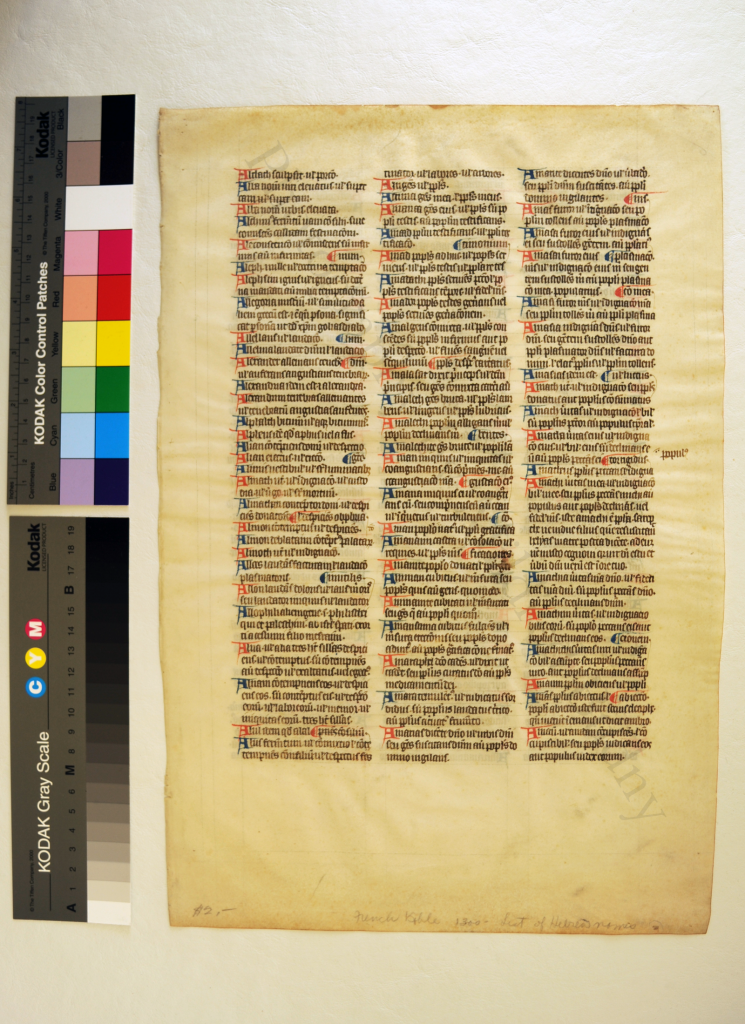
Private Collection, Leaf from Ege MS 14, with part of the A-Group of the ‘Interpretation of Hebrew Names’. Photograph by Mildred Budny.
Rogue Leaf: Enchiridion 21: Medieval Fragments for University Teaching & Research (2015), Item 2g
- Asseremoth . . . Azer
Rogue Leaf (2 of 2). Sotheby’s, Western Manuscripts and Miniatures (21 June 1994), lot 10(a.2), without plate
- with part of ‘the letter “I” ‘ (span unreported)
It is uncertain at present how many leaves intervened in the original sequence between the two identified so far in the A-Group. At least one leaf. It is also uncertain (to me) how the glossary ended, and if it was complete to Z.
More leaves could indicate to which variant the Glossary belonged.
The record of 1931 (Sotheby’s lot 329) reveals that this text spanned an impressive part of the volume. It stretched from folio *465r onward, perhaps fully to as far as folio *503 (recto? verso?), in 38 leaves at most. Also, like ‘the first three leaves’ of the volume’, the last leaves (number unspecified) of the book were damaged: ‘a few leaves of the Table at end are somewhat stained’.
Presumably ‘the Tables’ means the Interpretationes Nominorum Hebraeorum. (Unless, say, some other accompanying texts as well?) The stains perhaps represented the same sort of moisture damage visible on the Randolph College leaf at the front with part of the First Prologue for the Vulgate Bible and, probably, on the preceeding, first, leaf of that Frater Ambrosius prologue.
Because, so far, so few leaves from the Glossary portion of Ege MS 14 are identified, it seems probable that more await recognition. However, the leaves with multiple columns of text, without much if any of the decoration which charactizes most known leaves from the Bible portion — whether in historiated initials, extensions into the margins, foliage, creatures, and the like — may rule out a ready identification, or, for that matter, much interest among those collectors, curators, or scholars who would focus upon the “art” of the book, never mind the “boring” lists.
The first impetus for my interest in Ege Mauscript 14 came from a long acquaintance with the solitary leaf with the Alcath . . . Ananias portion of the INH. But, then, I have a long interest in the history, development, transmission, and adaptations of glossaries, proto-dictionaries, and dictionaries, as witness The Illustrated Catalogue.
It did take time to recognize which large-format Bible formerly held this text, where the text stood (whether before or after the Bible text), and so on. A clincher came in identifying the pencil inscription at the foot of the page as the work, and the wording, of Otto Ege for this dismembered book.

Pencil Inscription (Budny Handlist 9)
All Bound Up
At the time of the 1931 sale, the sale catalogue reported that the volume still had its binding of “17th Century calf over stout wooden boards”, with the “binding worn and upper cover loose”. We might conjecture that the damage to the front and back of the text block arose from an exposed state, with water or other liquid damage affecting those front and back leaves as well as, if the book was bound rather than unbound, the covers of an earlier binding.
Such a condition of water or other liquid damage at the outsides could have led to a 17th-century rebinding or repair. It is a pity that the modern binding, with all its evidentiary value of whatever kinds, was removed and discarded from sight in the 20th-century dismemberment of the monument.
A Binding at the Beinecke
As with some other Ege manuscripts, the residue of the book, left after the process of selection of choice Specimens, remains to some extents. Such seems to be the case with the sale of many leaves of Ege MS 14 en bloc which mostly reached the Schøyen Collection, and with the acquisition of the Otto Ege Collection by the Beinecke Rare Books & Manuscript Library.
Part of the former cover of Ege MS 14 was exhibited along with other portions of the volume when they reached the Beinecke.
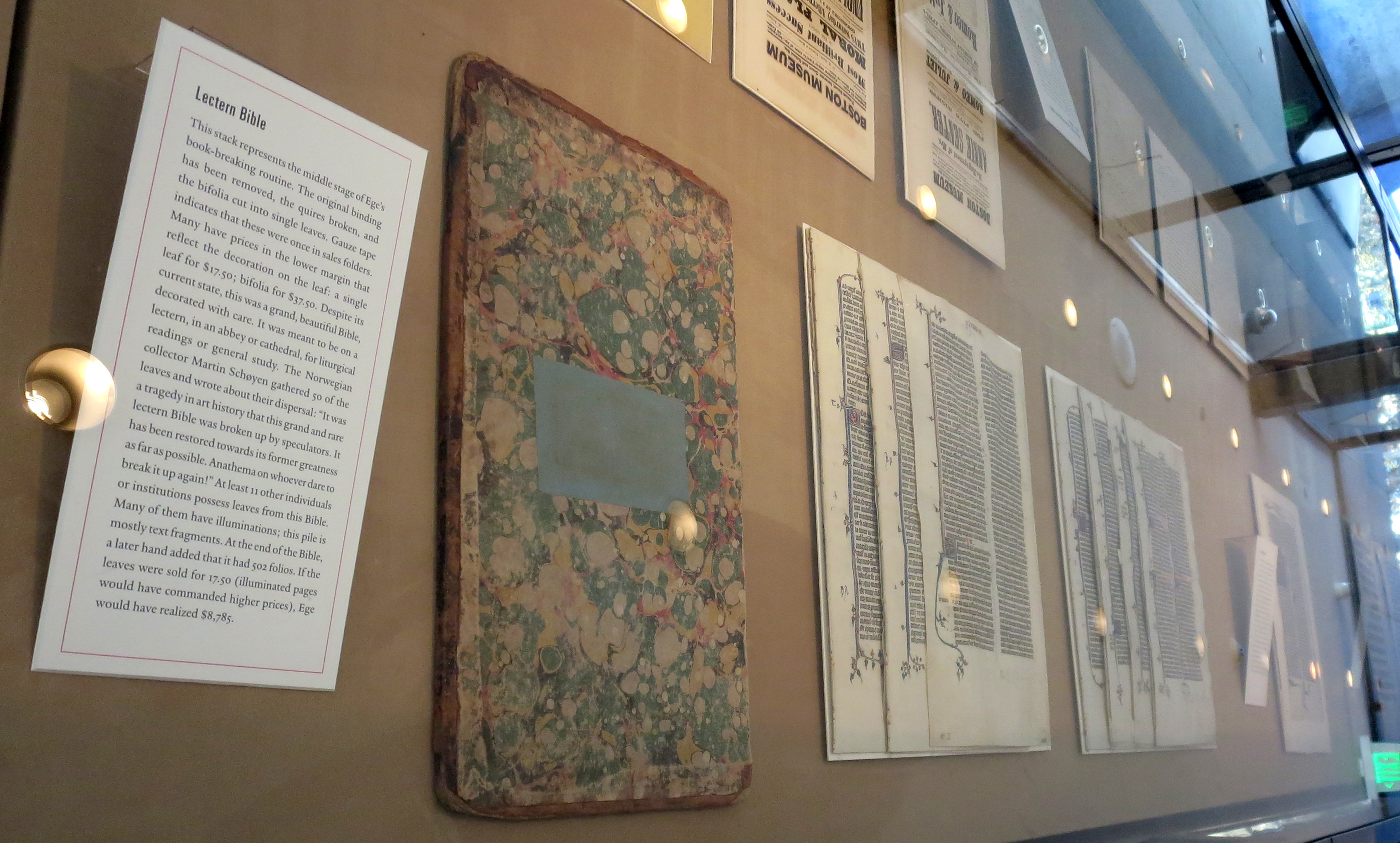
Beinecke Rare Book & Manuscript Library, Otto Ege Collection, New Acquisitions Exhibition (2016). Ege MS 14 in pieces.
From what I could see through the glass case, it appears to be the front cover, turned to show the inside, with its marbled pastedown, beyond which extends the edges of the leather-covered board. The worn surfaces of the rounded corners expose the backing, which seems to resemble layers of cardboard. A rectangular blue slip (paper?) is pasted to the midsection of the pastedown. The slip is probably a bookplate, although any image or text across its center seems too rubbed to reveal its intended message.
The 1931 description of the binding, with its “upper cover loose”, implies that the front cover would easily have been lifted away in Ege’s hands, to surface decades later in the exhibition case along with other remnants of the volume.
Because the front cover does not show signs of damage similar to the Randolph College Leaf, we could reasonably conjecture that those effects occurred at an earlier stage in the life of the book, before it received the modern trade binding.
To that binding work we should attribute the red stain at the outer edges of the manuscript leaves, applied to the book-block as a unit.
Seen from the side:
Viewed straight on, through glass:
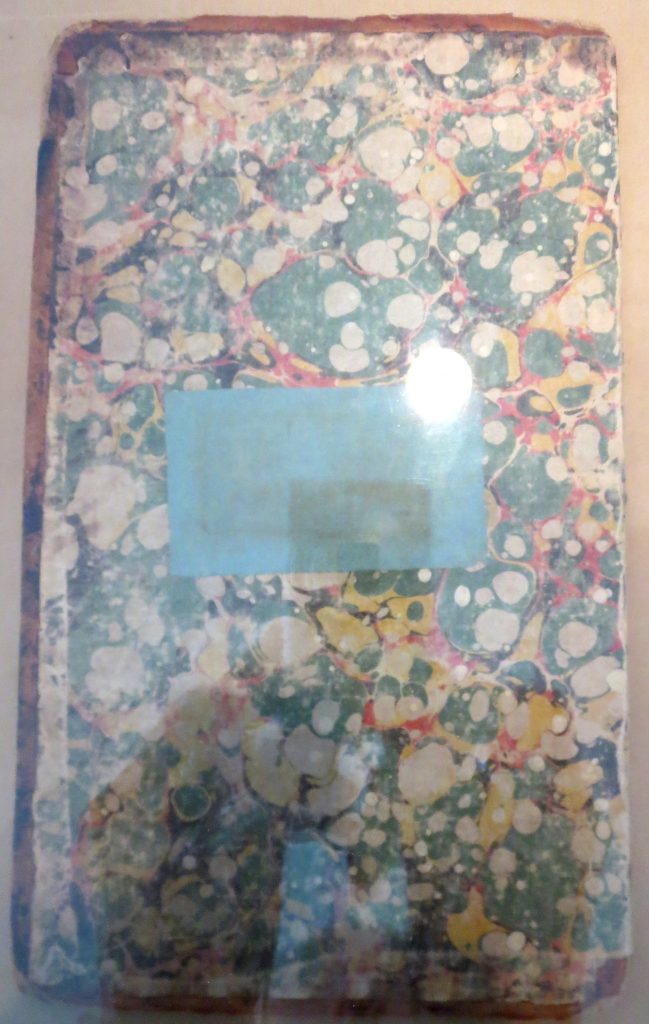
Beinecke Rare Book & Manuscript Library, Otto Ege Collection, Ege ME 14 Binding Board and Endpaper with bookplate(?).
Without seeing the front of the board or its other parts, we have the evidence of the inside cover and outer edges.
Perhaps the marbled paper, within the tradition of this genre of bookbinding materials, might help to narrow down the location and date of this cover. Image-enhancement might reclaim features of the book-plate.
Meanwhile, it is possible to consider features of the marbled paper. Convenient guides, often with specimens. appear in print and online. Among many:
- Richard J. Wolfe, Marbled Paper: Its History, Techniques, and Patterns, with special reference to the relationship of marbling to bookbinding in Europe and the Western World (New Castle, Delaware: Oak Knoll Press, 2nd edition with corrections, 2018)
- Einen Miura, The Art of Marbled Paper: Marbled Patterns and How to Make Them (Kodansha, 1991)
- Carina Greven, “The Development of a Standard Nomenclature for Marbled Paper”, Ink & Gall, 7:2 (Winter, 1993), pp. 10–113
- The Phoebe Jane Easton Bibliography: Marbling Bibliography
- Essay: Marbled Papers and Marbled Paper Patterns, University Libraries, University of Washington, Digital Collections
- We Love Endpapers: Public Group on Facebook
Among pattern types, as exhibited, for example, here, the design on the former cover for Ege MS 14 corresponds to the “Turkish” pattern (also known as “Spot”, “Stone”, “Agate, “Stein”, “Achat”, and Caillouté Simple”).
This is the oldest of Western marbled patterns and date back to as early as the middle part of the 15th century. The pattern is created when one or more colors are thrown onto the surface of the bath using a marbling brush. The first colors through tend to constrict as others follow and become the ‘vein’ colors for the latte thrown inks.
. . . Since this pattern is probably the earliest and the most simple it also is the base or jump off point for a large number of other patterns.
Specimens are exhibited in Wolfe, Marbled Paper, plate XXVI, 44–48 and Muira, Art of Marbled Paper, pages 47–49, and Turkish Patterns. In the latter gallery, an example similar to the front endpaper from Ege MS 14 is listed as Vintage 17th c. marbled paper, Turkish pattern, from a book cover. dating “between 1800 and 1899” [sic].
In consultation, Simon Beattie, founder of We Love Endpapers, suggested this in an email communication:
that marbled paper makes me say ’18th-century, English’. It certainly doesn’t look 17th-century (that’s not to say the binding wasn’t 17th-c., but with later endpapers).
Further research may uncover more secrets of the binding history of the book. Perhaps the most recent of its bindings, represented by the remnants, endpaper(s) included, in which it travelled to Ege can shed light on the transmission of its ownership to and through the unnamed “Italian gentleman” who consigned it for sale in London in 1936.
*****
The Stitching Patterns
The patterns of holes for the stitching(s) of the volume are visible in the gutters, or inner folds, of bifolia. Likewise, most of the single leaves, which have been severed from their mates in former bifolia, retain holes or notches from the same patterns.
Some bifolia or groups of leaves retain dark, thick, stains and ‘encrustations’ at the outside of their spines from the glued back of the leather-covered binding. A thickly crusted case can be seen on the recto of the single leaf from II Chronicles 4–6 at Stanford University, at the front of Quire xiiii.
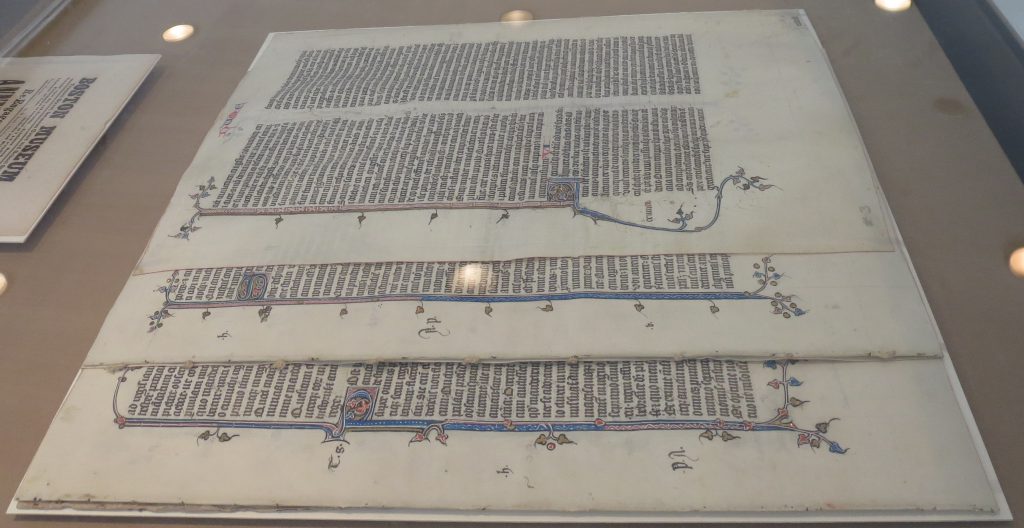
Beinecke Rare Book & Manuscript Library, Otto Ege Collection, New Acquisitions Exhibition (2016). Ege MS 14 in pieces. Stack 1, Segments 1-3.
A few leaves retain pieces of the yellowish thread, twisted twine, and cord used for the stitching threads which linked quire to quire for the bound unit in a ladder-like structure of horizontal rows across the spine of the book, and for the raised bands at the back, or outside, of those rows.
For example, near the top of the recto of the Ecclesiastes Leaf at Ohio University, the frayed ends of a pair of severed threads rise from the uncut hole alongside the nicked, open-sided hole in the fold of the gutter. The markedly uneven cut edge of this gutter, which contrasts with the straighter edge of many severed single leaves from the manuscript, attests to a rougher approach.
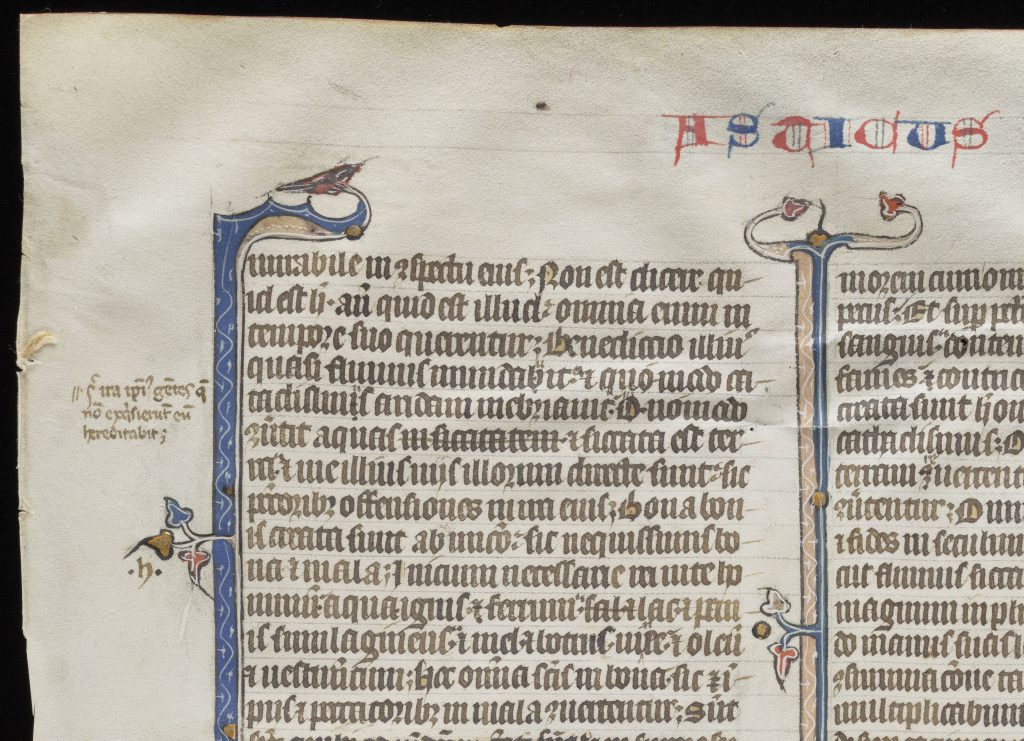
Ohio University, Leaf from Ege MS 14, recto, detail: Top left. Image Public Domain.
The inside of some bifolia show their stitching patterns clearly. Such is the case with the bifolium from Ezekial at the Cleveland Museum of Art.

Cleveland Museum of Art, Bifolium from a Bible: (Ege MS 14), with parts of Ezekiel via https://clevelandart.org/art/1959.272. Image Public Domain via Creative Commons.
The patterns derive from holes made in different approaches to binding or rebinding the volume. A close-up view shows differences in size, shape, and coloration between different ‘strata’ or sequences of stitching.

Cleveland Museum of Art, Bifolium from a Bible: (Ege MS 14), with parts of Ezekiel via https://clevelandart.org/art/1959.272. Image Public Domain via Creative Commons.
A detailed study across quires, insofar as they might be accessed, could determine the probable number of sewing interventions which the manuscript underwent in its history, from its original production, to individual ownership (Mirmellus Arnandi), to communal ownership (an unidentified Dominican convent), and back again (its “Italian” owner consigning the Bible to sale in London in 1936, and some other owner consigning it to sale again in New York).
*****
The Patched Repairs for Cut-Out Initials
In passing, we have noticed that a few leaves are said to have patched repairs taken from “the same” manuscript or volume. Such is the case for 2 catalogue entries.
1) Rogue Leaf = Gwara, Handlist 14.1.
Boston University = Judith H. Oliver, Manuscripts Sacred and Secular (1985), number 36 [but no plate]
- End of Kings, Prologue to I Chronicles, and beginning of I Chronicles
with a ‘patch taken from another illuminated page of the same manuscript’ covering the cut-out from the ‘theft of initial for I Chronicles’.
[One wonders which other page yielded its riches to patch up this leaf.]
When first noting the case in the leaf opening I Chronicles (A New Leaf from ‘Otto Ege Manuscript 14’), I observed that “One wonders which other page yielded its riches to patch up this leaf”.
2) Rogue Leaf = Gwara Handlist 14.Ref 14.
Sotheby’s 10 July 2012, lot 2(b)
- Opening of the Catholic Epistle of James on verso (illustrated online for the catalogue)
described in the Sotheby’s catalogue thus:
(b) leaf from a lectern Bible, 400mm. by 270mm., . . . area of one column cut away (90mm. by 95mm., presumably once with a large initial), now repaired with another cutting from same volume [highlights added], once mounted on card with remains of tape on recto [therefore, turned front-to-back in Ege’s matting to display the verso], France or southern Flanders, early fourteenth century.
The text presents the end of the Prologue to the Catholic Epistle of James (from [ut quia Petrus /] est primus in ordine apostolorum) and the opening of this Book, with 1:1–2:4 (nonne iudacitis [/ apud vosmet]).
Even though the catalogue does not specify the position and nature of the patch, it is possible to make some educated guesses.
Next, we examine these patches.
*****
We thank the owners for the opportunity to study and to reproduce the leaves.
Do you know of more leaves from this manuscript? Do you recognize the hands of these scribes, artists, and annotators in other manuscripts?
You might reach us via Contact Us or our Facebook Page. Comments here are welcome too. We look forward to hearing from you.
Watch our blog on Manuscript Studies for more discoveries. Please visit its Contents List.
[Update: See
*****
